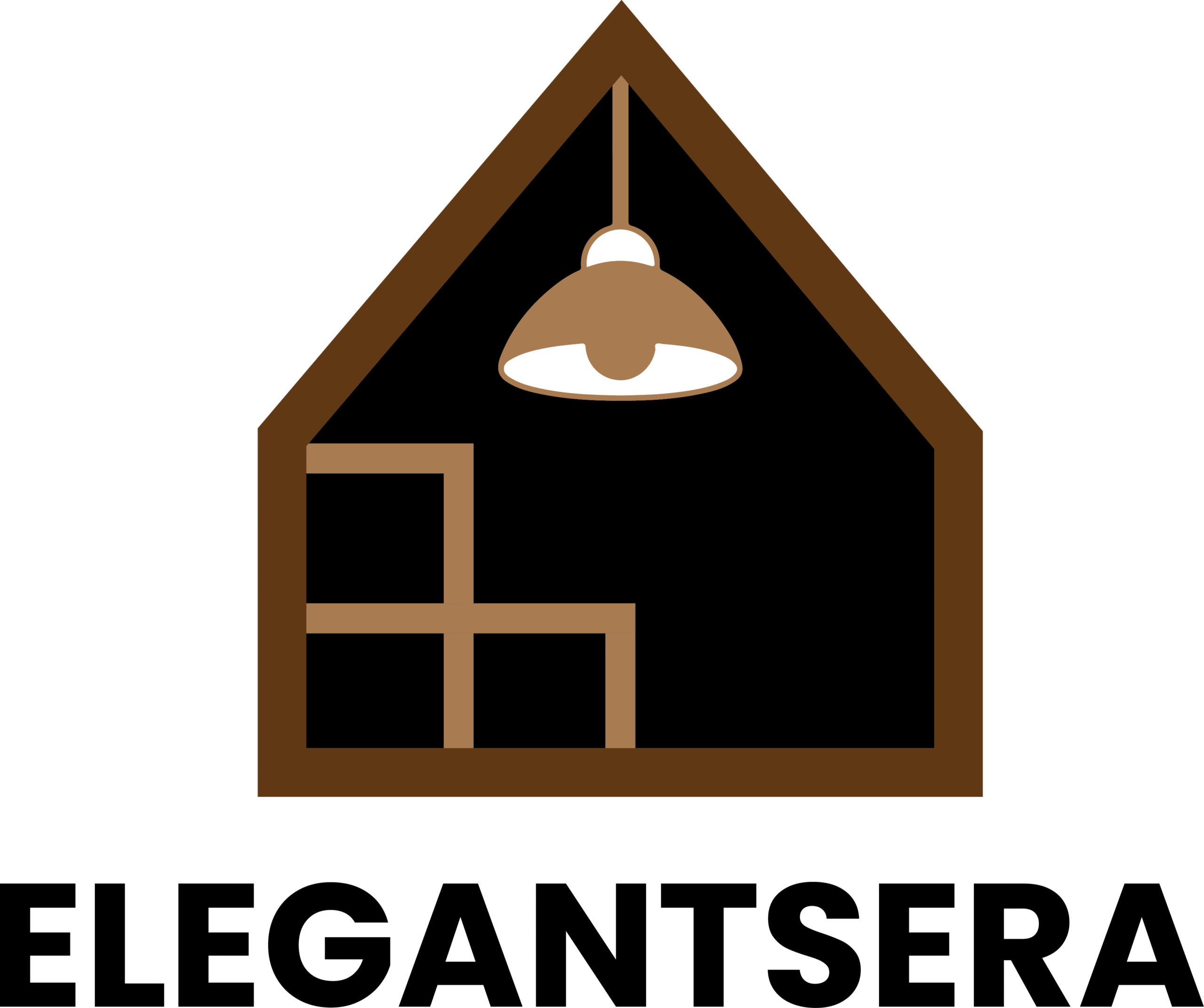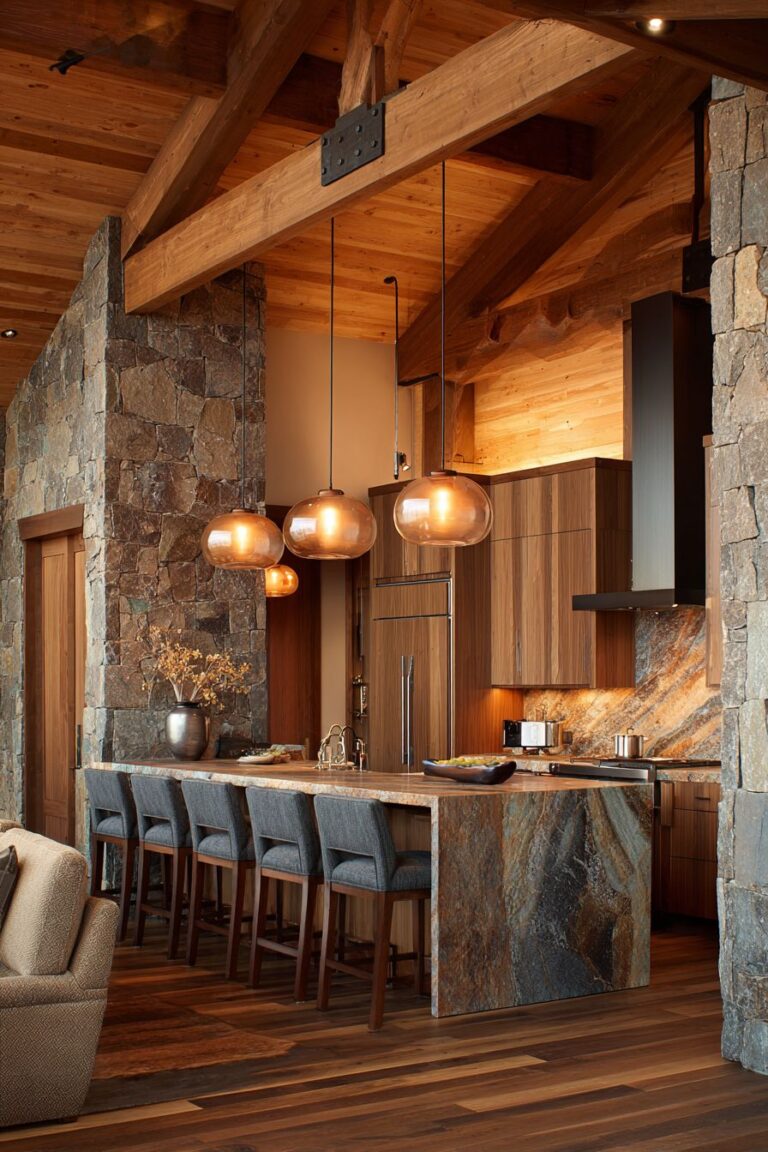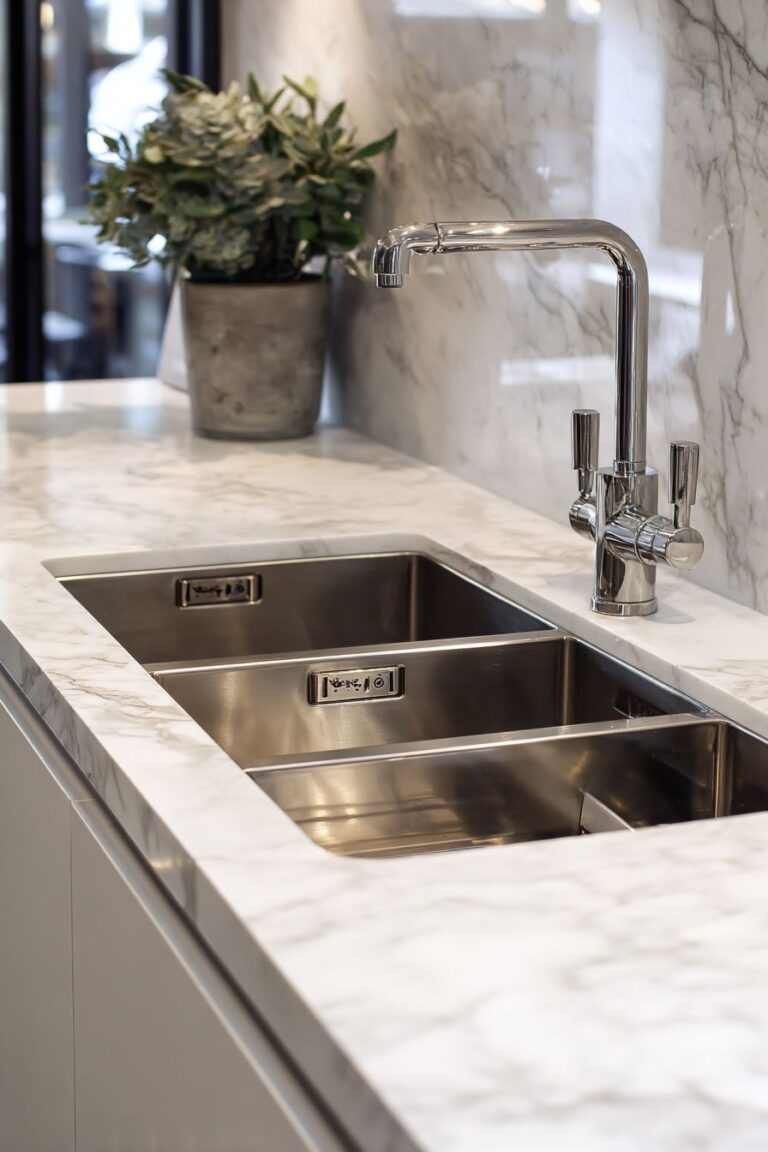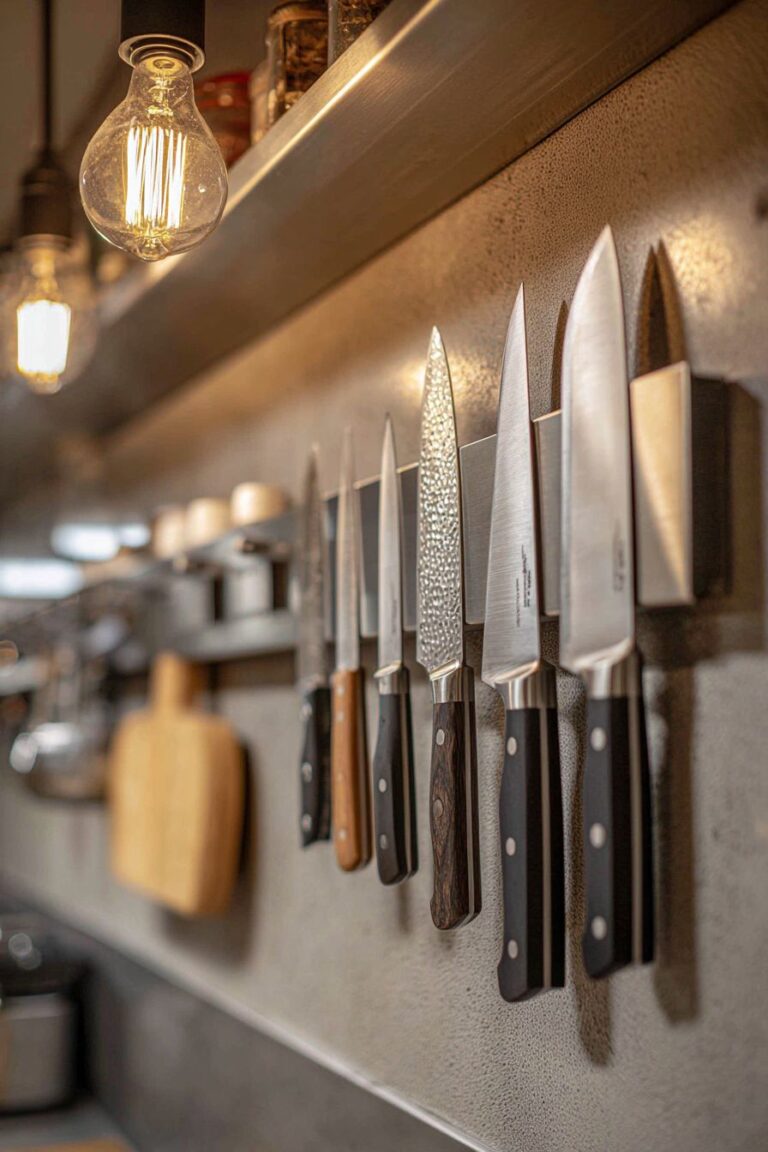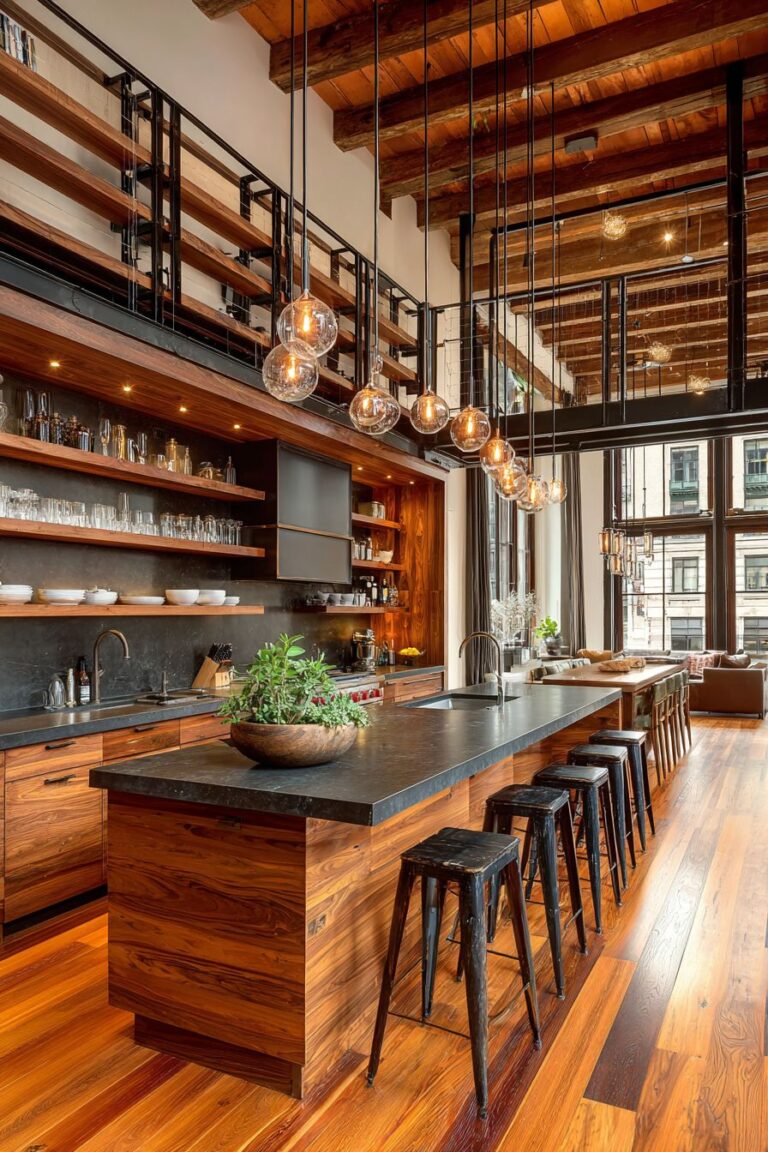20 Beautiful Kitchen Curtain Ideas for Every Style
The heart of every home deserves thoughtful attention to detail, and few elements can transform a kitchen’s atmosphere as dramatically as the perfect curtains. Kitchen curtains serve as more than mere window coverings; they’re essential design components that bridge functionality with aesthetic appeal, controlling natural light while adding personality, color, and texture to your culinary sanctuary. Whether you’re drawn to the rustic charm of farmhouse designs, the sleek sophistication of modern minimalism, or the eclectic vibrancy of bohemian styles, the right kitchen curtains can elevate your space from ordinary to extraordinary.
The kitchen environment presents unique challenges that make curtain selection particularly important. Unlike other rooms in the home, kitchens demand fabrics that can withstand humidity, cooking odors, and frequent cleaning while maintaining their beauty and functionality. The interplay between natural light and cooking activities requires careful consideration of opacity, color, and style to create a space that’s both practical and inspiring. From café curtains that provide privacy while maximizing light to dramatic floor-to-ceiling panels that make bold architectural statements, the variety of kitchen curtain options available today caters to every design preference and practical need.
This comprehensive guide explores twenty distinct kitchen curtain ideas, each representing a unique approach to window treatment design. From the timeless appeal of gingham café curtains to the luxurious drama of velvet panels, these concepts demonstrate how thoughtful curtain selection can complement and enhance every kitchen style, from cozy cottages to urban lofts, creating spaces that reflect your personal aesthetic while meeting the practical demands of daily culinary life.
1. Cozy Farmhouse Elegance with White Linen
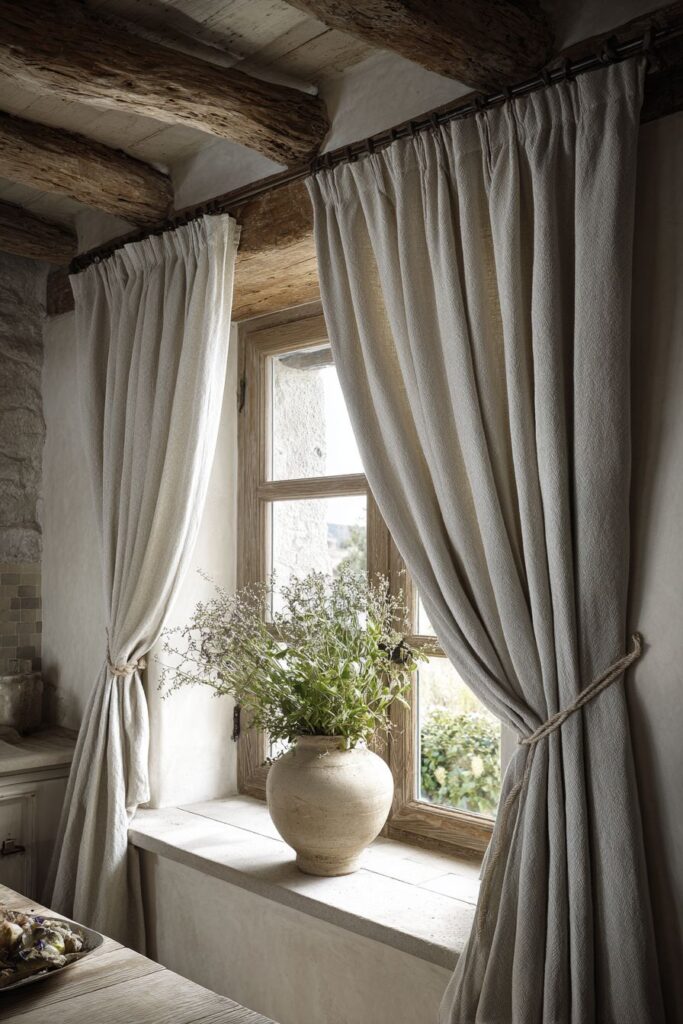
The farmhouse kitchen aesthetic reaches its pinnacle when white linen curtains frame sun-drenched windows, creating an atmosphere of rustic sophistication that feels both timeless and thoroughly modern. These elegant white linen panels, suspended from weathered wooden rods, embody the perfect marriage of functionality and beauty that defines authentic farmhouse design. The subtle texture inherent in quality linen fabric catches and diffuses morning light beautifully, creating soft, ever-changing patterns across subway tile backsplashes and weathered wooden surfaces.
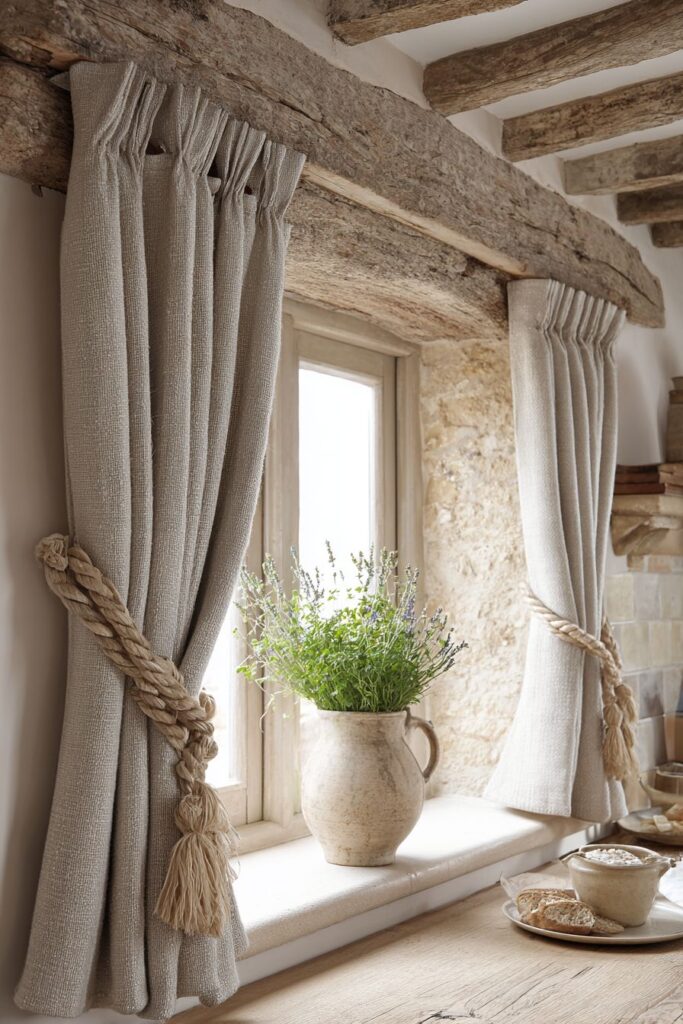
Natural jute tie-backs add an organic element that speaks to the farmhouse philosophy of bringing the outdoors in, while their practical function allows for flexible light control throughout the day. The gathering of the fabric creates gentle pleats that add visual interest without overwhelming the space’s clean lines. Fresh herbs displayed in vintage ceramic vessels on the windowsill complement the curtains’ natural aesthetic, creating a cohesive design narrative that celebrates both form and function.

The professional staging of such spaces often incorporates exposed wooden beams overhead, which echo the curtain rod’s rustic material and create architectural continuity. The interplay between the crisp white linen and the warm wood tones establishes a color palette that’s both soothing and energizing, perfect for the kitchen’s dual role as workspace and gathering place.
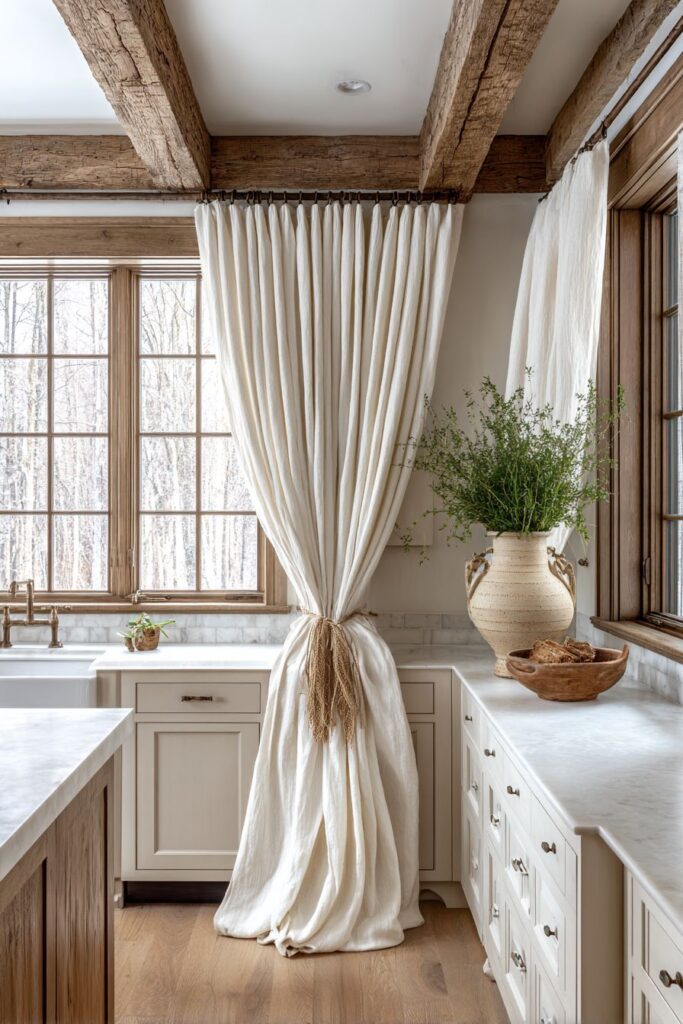
Key Design Tips:
- Choose linen with natural texture variations to add visual depth and authenticity
- Install wooden rods with visible grain patterns to enhance the rustic farmhouse aesthetic
- Use natural fiber tie-backs like jute or hemp rope for consistent material storytelling
- Position herbs or simple ceramic vessels on windowsills to complement the organic theme
- Maintain consistent white and natural wood color palette throughout the space
- Allow fabric to pool slightly for a relaxed, lived-in appearance
2. Modern Minimalist Sophistication in Grey
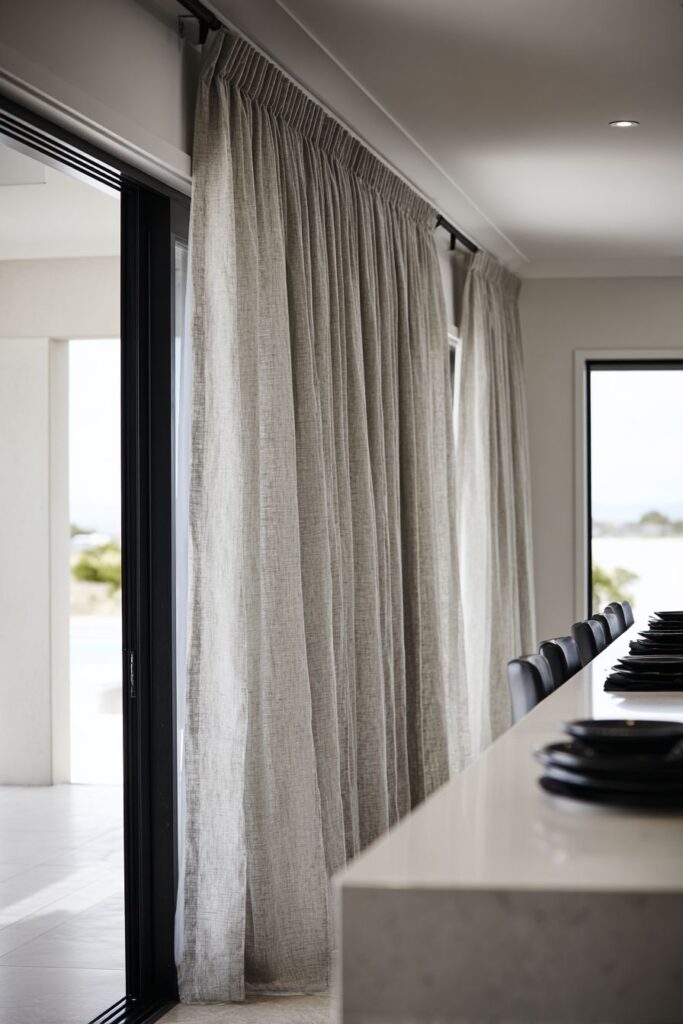
Contemporary kitchen design finds its perfect expression in clean-lined grey linen panels that demonstrate how restraint can create maximum visual impact. These minimalist curtains, characterized by their precise tailoring and subtle gathering, suspend from sleek black metal rods that serve as architectural elements in their own right. The monochromatic palette of grey fabric against white quartz countertops and stainless steel appliances creates a sophisticated harmony that speaks to modern design principles of simplicity and functionality.
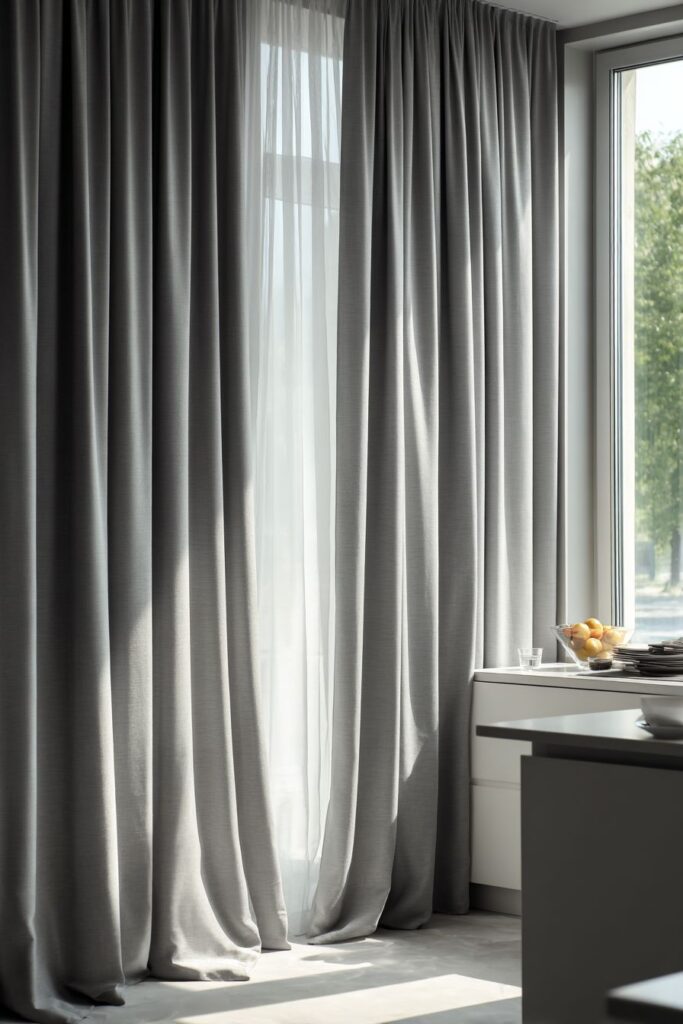
The quality of natural daylight filtering through these panels becomes a design element itself, creating soft shadows that change throughout the day and add dynamic visual interest to the contemporary space. The wide-angle perspective reveals how these understated curtains contribute to the kitchen’s sense of spaciousness while providing necessary privacy and light control. The fabric’s minimal gathering prevents visual clutter while still allowing for gentle movement that softens the space’s harder architectural elements.
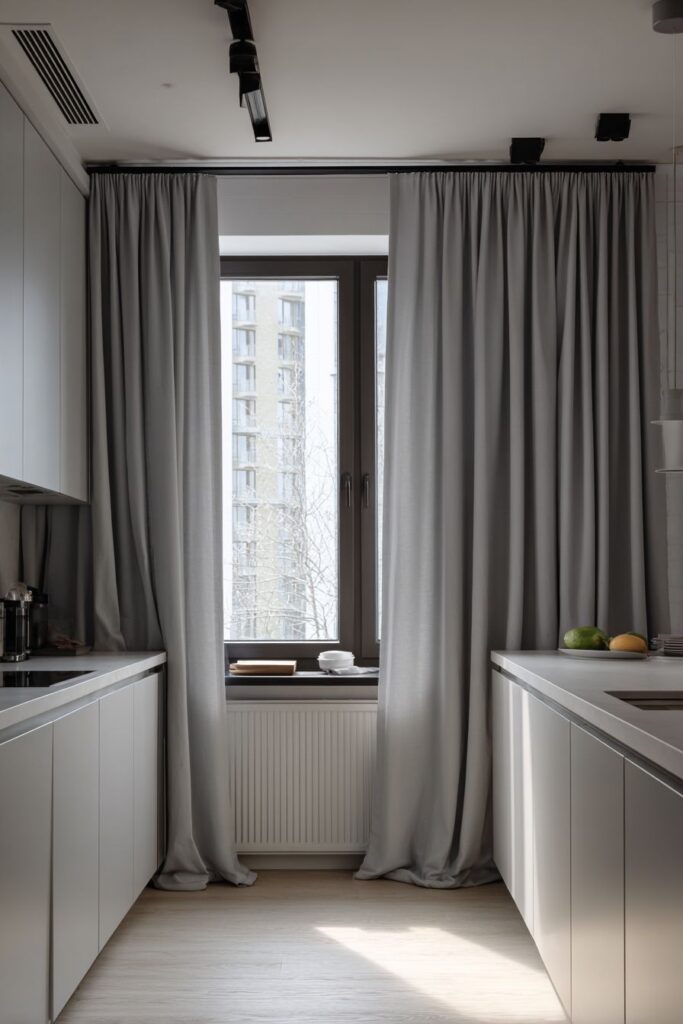
Professional interior photography captures the sophisticated interplay between textures – the smooth quartz surfaces, the brushed metal finishes, and the organic linen weave – demonstrating how thoughtful material selection creates depth within a restrained color palette. The curtains’ role extends beyond mere window covering to become integral components of the space’s overall design strategy.
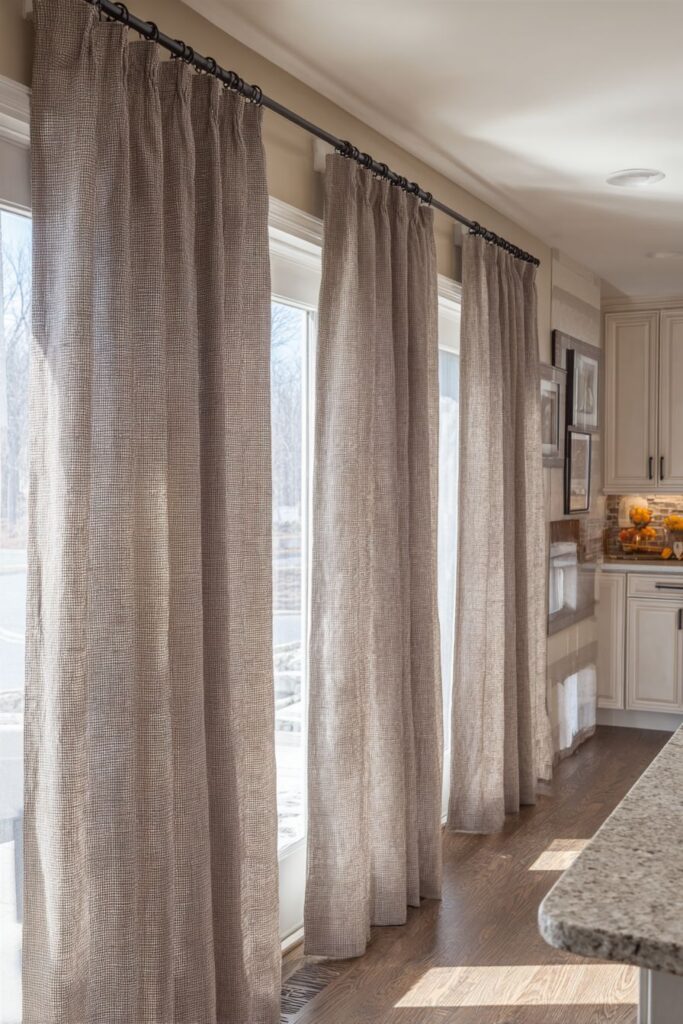
Key Design Tips:
- Select metal hardware in matte black or brushed steel for contemporary appeal
- Minimize gathering to maintain clean, architectural lines
- Choose neutral grey tones that complement rather than compete with existing finishes
- Position curtains to frame views rather than obstruct natural light
- Coordinate fabric weight with the space’s scale to maintain visual balance
- Avoid decorative tie-backs or excessive hardware details
3. Bohemian Warmth with Layered Textures

The bohemian kitchen embraces creative expression through layered sheer curtains in warm terracotta and cream tones, creating a window treatment that celebrates artistic freedom and cultural richness. These flowing panels, adorned with subtle geometric patterns, transform ordinary windows into canvases that tell stories of global inspiration and creative living. The macrame tie-backs add handcrafted authenticity that speaks to the bohemian philosophy of celebrating artisanal skills and natural materials.

Brass curtain rings catch and reflect the golden hour light, creating sparkles that dance across open wooden shelving lined with colorful ceramics and thriving plants. This interplay between metallic accents and organic elements exemplifies the bohemian approach to design, where every surface becomes an opportunity for personal expression. The curtains’ ability to move and flow with air currents adds a dynamic quality that keeps the space feeling alive and energetic.

The layering technique employed here – combining different opacity levels and complementary colors – demonstrates sophisticated understanding of how light and texture can be manipulated to create mood and atmosphere. The warm color palette of terracotta and cream establishes a foundation that supports the eclectic collection of objects and accessories that define bohemian style.

Key Design Tips:
- Layer different opacity fabrics to create depth and light control options
- Choose warm, earth-toned colors that complement eclectic accessories
- Incorporate handcrafted elements like macrame tie-backs for authentic bohemian appeal
- Use brass or copper hardware to add warm metallic accents
- Allow fabrics to move freely to create dynamic visual interest
- Coordinate patterns with existing textiles while maintaining visual balance
4. Traditional Charm with Café-Style Gingham

The timeless appeal of café-style curtains reaches its peak expression in classic blue and white gingham check patterns that evoke memories of country kitchens and simpler times. These half-window treatments, suspended from white painted wooden rods with simple rings, strike the perfect balance between privacy and light, covering the lower portion of double-hung windows while allowing maximum natural illumination to flood the upper space. The crisp geometric pattern adds visual interest without overwhelming the traditional aesthetic.

Positioned above a classic farmhouse sink, these curtains create a charming focal point that anchors the traditional kitchen design. The white shaker cabinets provide a clean backdrop that allows the gingham pattern to shine while maintaining the space’s overall sense of order and cleanliness. The nostalgic quality of this combination speaks to the enduring appeal of American country design traditions.

Professional interior photography captures how natural lighting emphasizes the curtain’s crisp pattern while highlighting the complementary traditional elements throughout the space. The scale of the gingham check is carefully chosen to provide pattern interest without overwhelming the space’s proportions, demonstrating the importance of scale consideration in successful pattern application.

Key Design Tips:
- Choose gingham check size appropriate to window and room scale
- Install café rods at mid-window height for optimal privacy and light balance
- Coordinate curtain colors with existing kitchen color scheme
- Use simple hardware to maintain traditional aesthetic integrity
- Position above kitchen sinks or prep areas for practical benefit
- Maintain crisp, clean appearance through regular laundering
5. Scandinavian Simplicity with Natural Elements
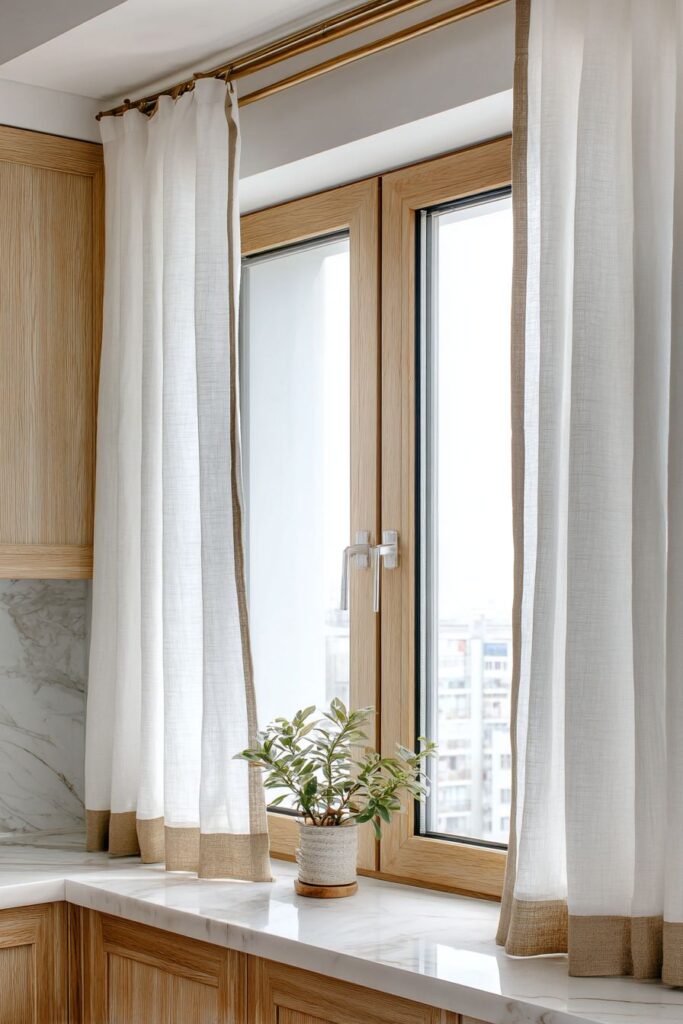
Scandinavian design principles find perfect expression in simple white cotton curtains adorned with natural hemp trim, creating window treatments that embody the Nordic philosophy of functional beauty and environmental consciousness. These understated panels, hanging straight from slim wooden dowel rods, maximize natural light penetration while providing gentle privacy screening. The minimalist approach allows the quality of materials and craftsmanship to speak for themselves.
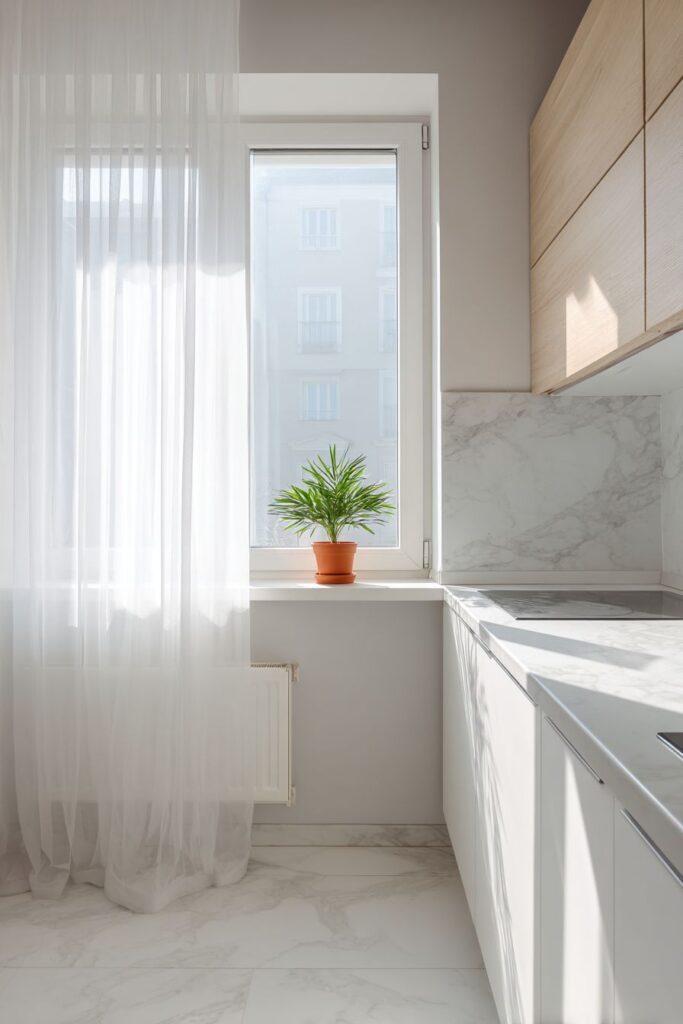
The bright kitchen setting, featuring light oak cabinets and pristine white marble countertops, provides an ideal backdrop for these restrained curtains. A small potted plant on the windowsill adds the essential touch of green that Scandinavian design requires, creating a connection to nature that’s fundamental to Nordic living philosophy. The overall effect is one of serene functionality that supports daily life without unnecessary complexity.

Wide-angle interior photography showcases how these simple curtains contribute to the space’s sense of openness and airiness while maintaining visual interest through subtle material contrasts. The hemp trim detail adds textural richness without disrupting the clean aesthetic, demonstrating how thoughtful details can enhance rather than complicate minimalist design approaches.
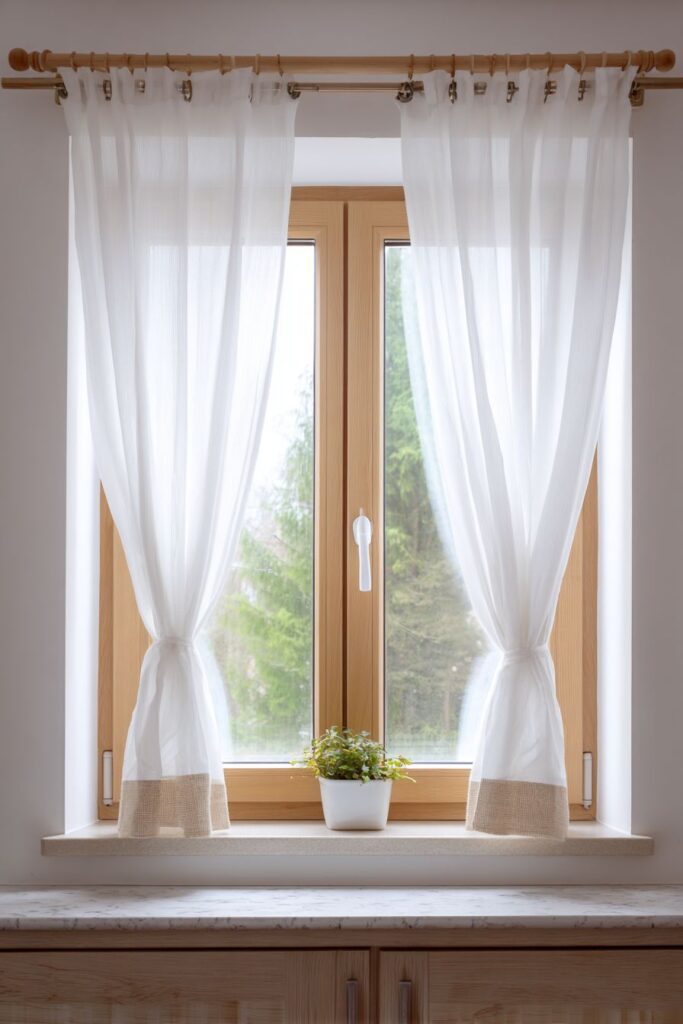
Key Design Tips:
- Select natural fiber fabrics and trims for authentic Scandinavian appeal
- Use minimal hardware in light wood tones to maintain design consistency
- Allow maximum light penetration through light-colored, lightweight fabrics
- Incorporate single green plant for essential natural element
- Maintain straight hanging lines without decorative gathering or tiebacks
- Choose white or off-white colors to enhance natural light reflection
6. Rustic Authenticity with Burlap and Lace

The rustic kitchen aesthetic achieves its most authentic expression through burlap curtains adorned with delicate cream lace trim, creating a compelling contrast between rough and refined textures that speaks to rural design traditions. These textural window treatments, suspended from substantial wrought iron rods with decorative finials, demonstrate how industrial hardware can complement natural fabrics to create cohesive rustic narratives. The burlap’s inherent texture and weave variations add visual interest that changes with shifting light conditions throughout the day.

Exposed brick walls and reclaimed wood countertops provide the perfect architectural backdrop for these organic curtains, while mason jar herb gardens lining the windowsill reinforce the theme of practical beauty that defines authentic farmhouse design. The integration of growing herbs serves dual purposes – providing fresh ingredients for cooking while adding living color that complements the earthy curtain materials.

Professional interior photography with warm lighting captures the interplay between the curtain’s natural texture and the kitchen’s substantial architectural elements. The cream lace trim softens the burlap’s rustic character while maintaining the overall casual aesthetic, demonstrating how contrasting textures can be successfully combined to create depth and visual interest.

Key Design Tips:
- Choose authentic burlap with natural texture variations for visual authenticity
- Add lace or cotton trim to soften the rustic material’s appearance
- Use substantial wrought iron hardware to support heavier fabric weight
- Coordinate with other natural materials like wood and stone
- Position herb gardens or natural elements on windowsills for thematic consistency
- Allow natural texture variations to add character and warmth
7. Contemporary Technology Integration with Sage Automation
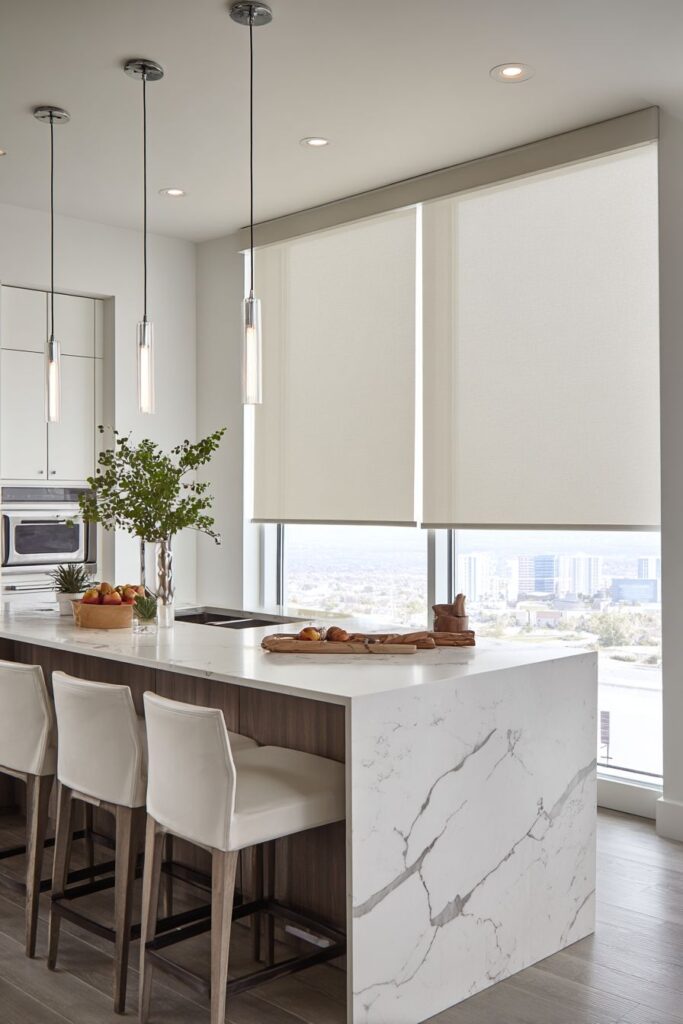
The intersection of technology and design finds sophisticated expression in motorized roller shades crafted in soft sage green, representing the cutting edge of contemporary window treatment solutions. These automated curtains, positioned strategically behind sleek kitchen islands with dramatic waterfall countertops, provide privacy control at the touch of a button while maintaining the clean architectural lines that define modern design. The sage green color adds subtle warmth to the space without disrupting its sophisticated neutrality.

The integration of smart home technology into window treatments represents a significant evolution in contemporary design thinking, where convenience and aesthetics merge seamlessly. Natural light filtering through the sage fabric creates subtle color variations that change throughout the day, adding dynamic visual interest to the modern kitchen setting. The automated functionality eliminates the visual clutter of cords and manual operation mechanisms.
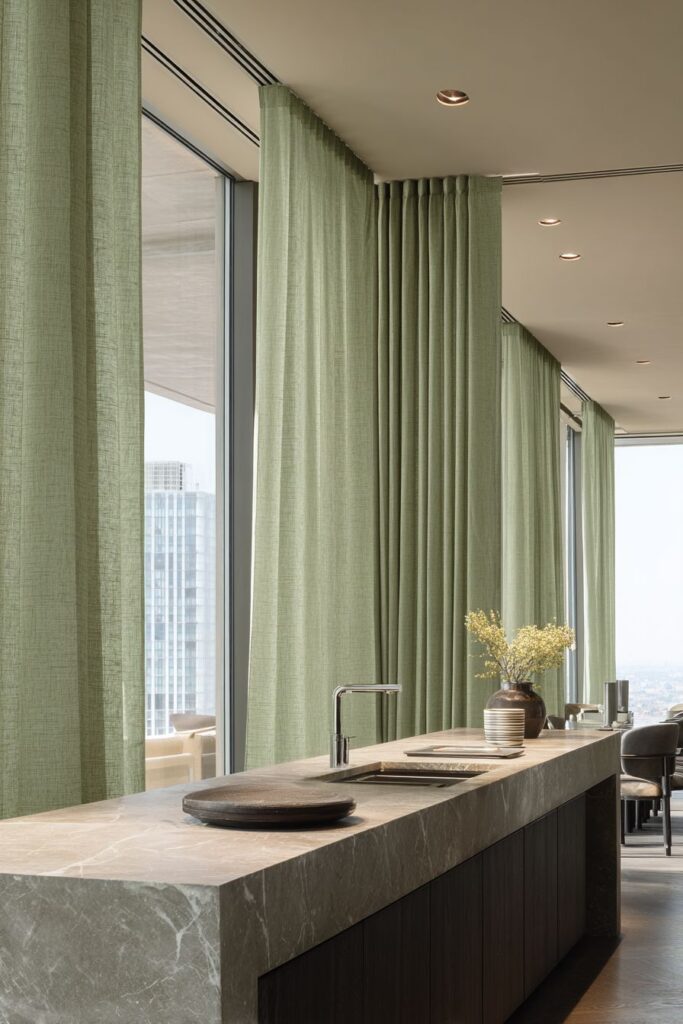
Interior design photography with balanced exposure captures the sophisticated integration of technology and style, demonstrating how motorized solutions can enhance rather than complicate contemporary spaces. The sage green color choice provides a connection to nature while maintaining the space’s overall modern aesthetic, proving that technology and organic elements can coexist harmoniously.
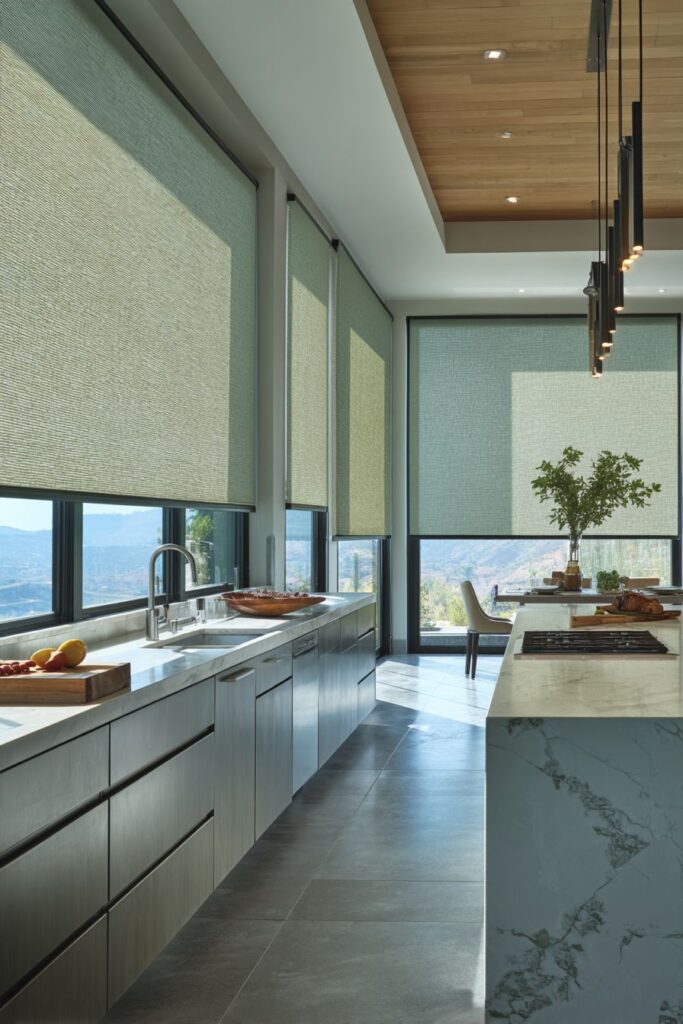
Key Design Tips:
- Choose automated systems with concealed motors for clean aesthetic integration
- Select colors that complement existing neutral palette while adding subtle warmth
- Position strategically to enhance privacy without blocking natural light
- Coordinate with other smart home systems for seamless operation
- Use quality fabrics that filter light beautifully while maintaining opacity options
- Consider room acoustics when selecting motorized system specifications
8. French Country Romance with Floral Toile

The romantic spirit of French country design blooms fully in delicate floral curtains featuring muted lavender and cream toile patterns that transport viewers to the pastoral landscapes of Provence. These gathered curtains, adorned with matching fabric tie-backs, frame windows above vintage farmhouse sinks with brass fixtures, creating vignettes that celebrate the French appreciation for beauty in everyday objects. The toile pattern tells visual stories that add narrative depth to the kitchen space.

Dried lavender bundles hanging nearby echo the curtain’s romantic pattern while adding natural fragrance that enhances the sensory experience of the space. This careful coordination between textile patterns and natural elements demonstrates the French country approach to design, where every detail contributes to an overall atmosphere of refined rusticity. The muted color palette creates sophisticated restraint while maintaining romantic appeal.

Soft natural lighting in professional interior photography highlights the curtains’ delicate pattern details while showcasing the kitchen’s provincial charm through distressed cabinetry and aged finishes. The interplay between the soft textile patterns and the weathered wood surfaces creates visual harmony that speaks to the French country philosophy of embracing age and patina as elements of beauty.
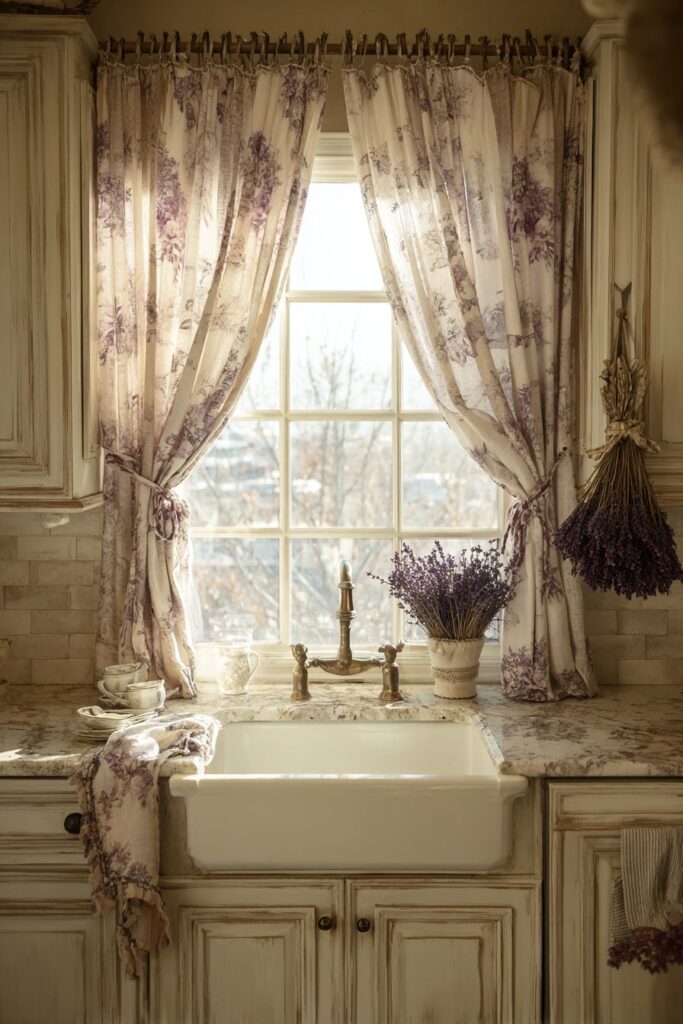
Key Design Tips:
- Choose toile patterns with appropriate scale for window and room size
- Use matching fabric tie-backs to create cohesive design narratives
- Coordinate colors with natural elements like dried herbs or flowers
- Pair with vintage or antique-style fixtures for authentic French country appeal
- Allow gentle gathering to create romantic soft folds
- Incorporate complementary scents through natural elements like lavender
9. Industrial Strength with Canvas and Steel
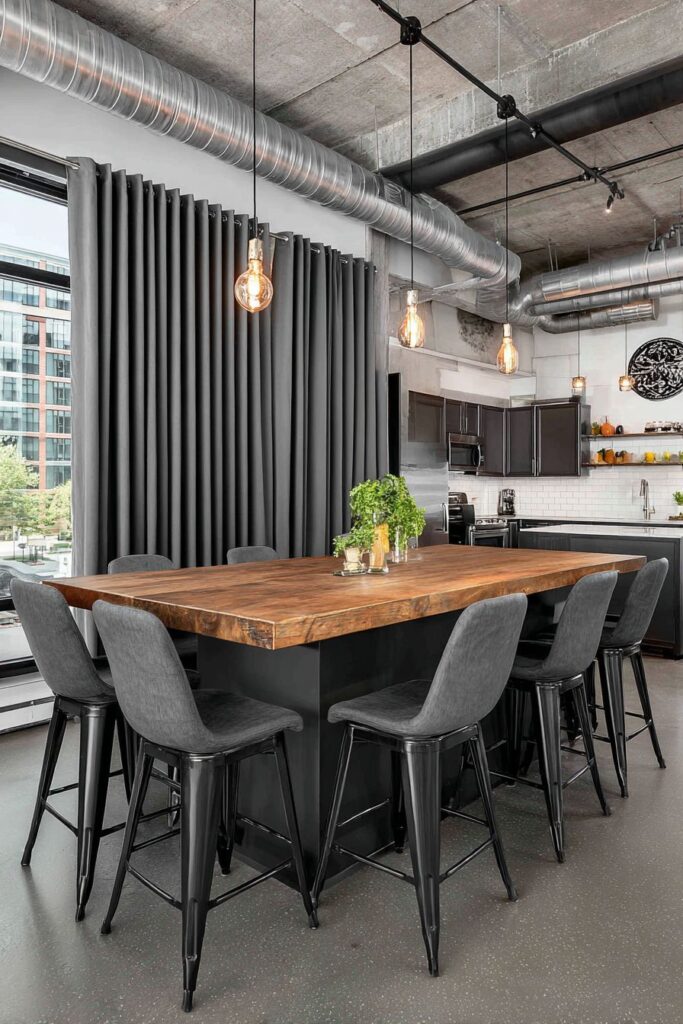
The industrial kitchen aesthetic finds its most powerful expression in heavy canvas curtains crafted in sophisticated charcoal grey, suspended from exposed black pipe curtain rods that celebrate rather than conceal structural elements. These utilitarian window treatments complement concrete countertops and exposed ductwork while introducing essential softness to spaces dominated by hard materials and angular forms. The substantial weight of canvas fabric provides excellent light control while adding textural warmth to industrial environments.
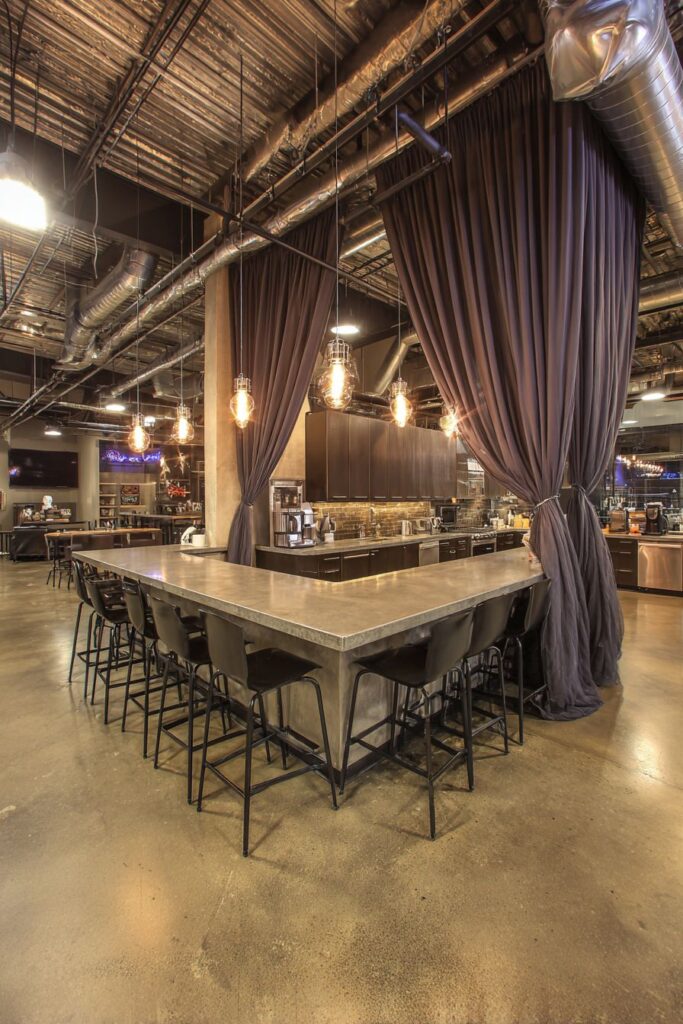
Edison bulb pendant lights create dramatic shadows through the curtain fabric, adding dynamic lighting effects that change throughout the evening hours. This interplay between artificial lighting and textile surfaces demonstrates how industrial design can incorporate atmospheric elements without compromising its essential character. The urban loft setting provides the perfect architectural framework for these bold window treatments.
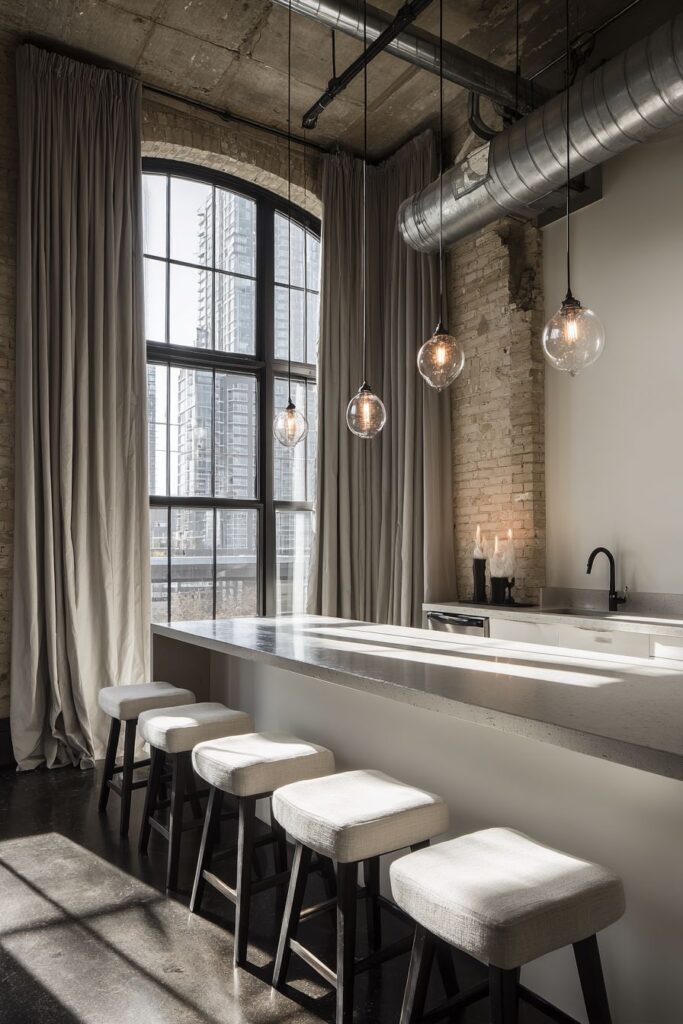
Wide-angle interior photography captures the successful balance between industrial authenticity and residential comfort, showing how substantial curtains can soften raw materials without diminishing their impact. The charcoal grey color choice provides sophistication while maintaining the darker palette characteristic of industrial design, proving that utilitarian materials can achieve unexpected elegance.
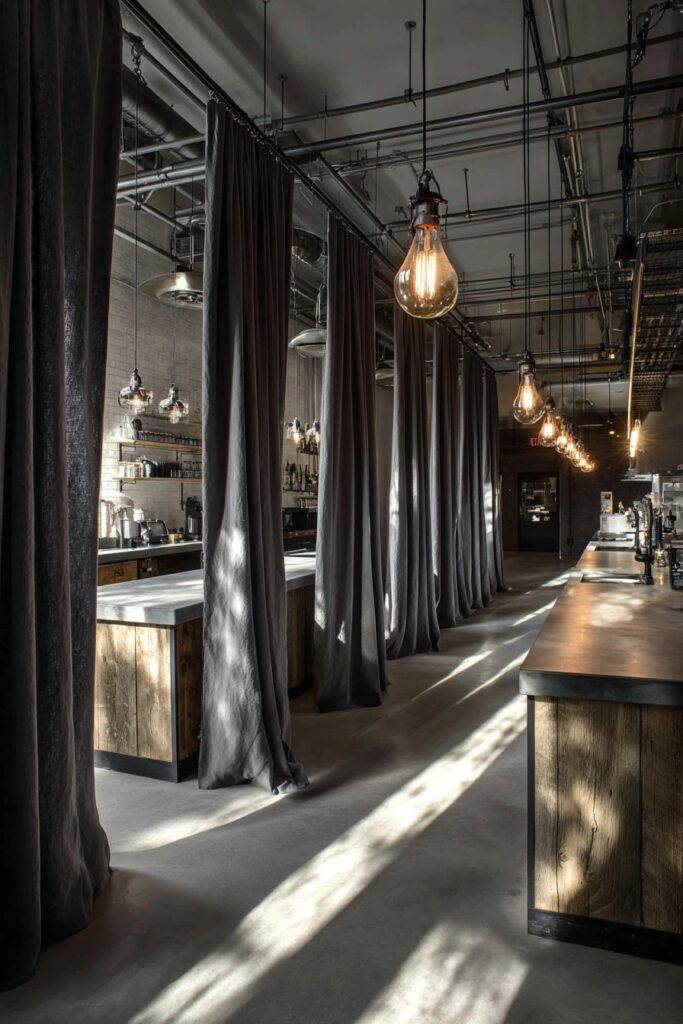
Key Design Tips:
- Select heavy-weight fabrics like canvas or duck cloth for authentic industrial appeal
- Use exposed pipe systems or substantial metal hardware for structural honesty
- Choose darker colors that complement concrete, steel, and brick materials
- Balance hard architectural elements with fabric softness
- Incorporate dramatic lighting to create shadow play through fabric
- Maintain utilitarian aesthetic while achieving residential comfort
10. Coastal Breeziness with Voile and Driftwood

The essence of coastal living finds perfect expression in lightweight white voile curtains that dance gently in ocean breezes, suspended from naturally weathered driftwood rods that bring authentic seaside elements indoors. These ethereal window treatments embody the coastal philosophy of creating spaces that feel connected to natural surroundings while maintaining relaxed sophistication. The airy fabric quality allows maximum light penetration while providing gentle privacy screening.

Rope tie-backs add nautical authenticity while serving practical functions, demonstrating how coastal design successfully integrates functional elements that tell environmental stories. The whitewashed cabinets and sea glass tile backsplash provide perfect architectural support for these breezy curtains, while shell and sea glass collections on windowsills reinforce the coastal narrative through natural found objects.

Professional interior photography with bright natural lighting captures the curtains’ movement and translucency, showing how these delicate fabrics can add dynamic visual interest to coastal kitchens. The weathered wood textures throughout the space echo the driftwood curtain rods, creating material consistency that supports the overall coastal aesthetic.

Key Design Tips:
- Choose lightweight, translucent fabrics that move easily with air currents
- Use authentic driftwood or weathered wood materials for curtain hardware
- Incorporate rope elements for nautical authenticity and natural texture
- Maintain light color palette to maximize natural light reflection
- Add natural found objects like shells or sea glass for coastal storytelling
- Allow fabric movement to create dynamic visual interest
11. Mediterranean Luxury with Olive Linen
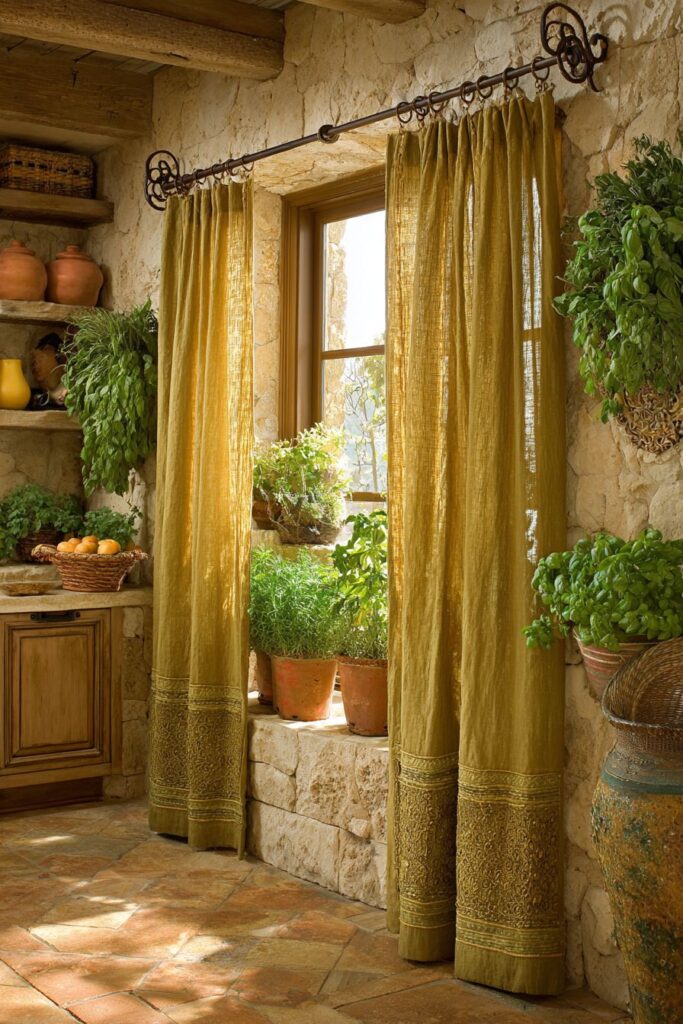
The warm sophistication of Mediterranean design reaches its zenith in rich olive green linen curtains featuring hand-stitched edges that speak to the region’s appreciation for artisanal craftsmanship and natural materials. These luxurious panels, suspended from wrought iron rods adorned with traditional scrollwork details, demonstrate how quality materials and skilled workmanship can create window treatments that age beautifully while maintaining their essential character. The deep olive color provides sophisticated earthiness that complements terracotta and warm wood elements.
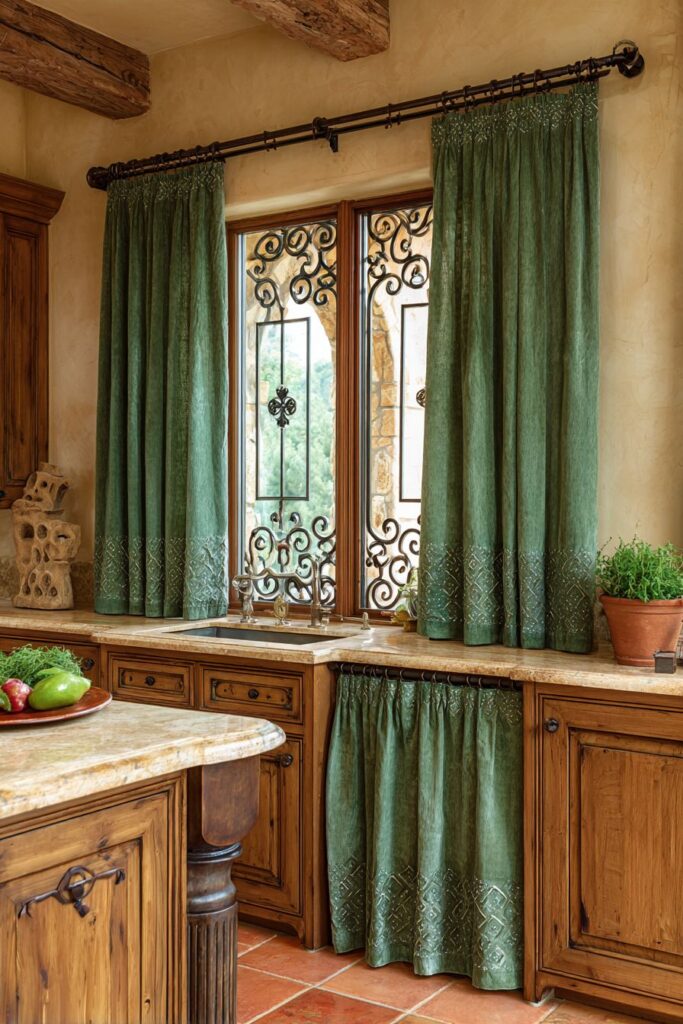
Terracotta tile flooring and warm wood cabinets create the perfect architectural framework for these substantial curtains, while fresh herbs growing in matching terracotta pots reinforce the Mediterranean connection to agricultural traditions and fresh ingredients. The integration of living elements adds organic vitality that keeps the space feeling fresh and connected to its cultural roots.

Interior design photography with golden hour lighting emphasizes the curtains’ luxurious texture while showcasing the kitchen’s Old World charm through natural stone accents and traditional proportions. The hand-stitched edges add artisanal quality that speaks to Mediterranean values of craftsmanship and attention to detail, proving that traditional techniques can enhance contemporary living spaces.
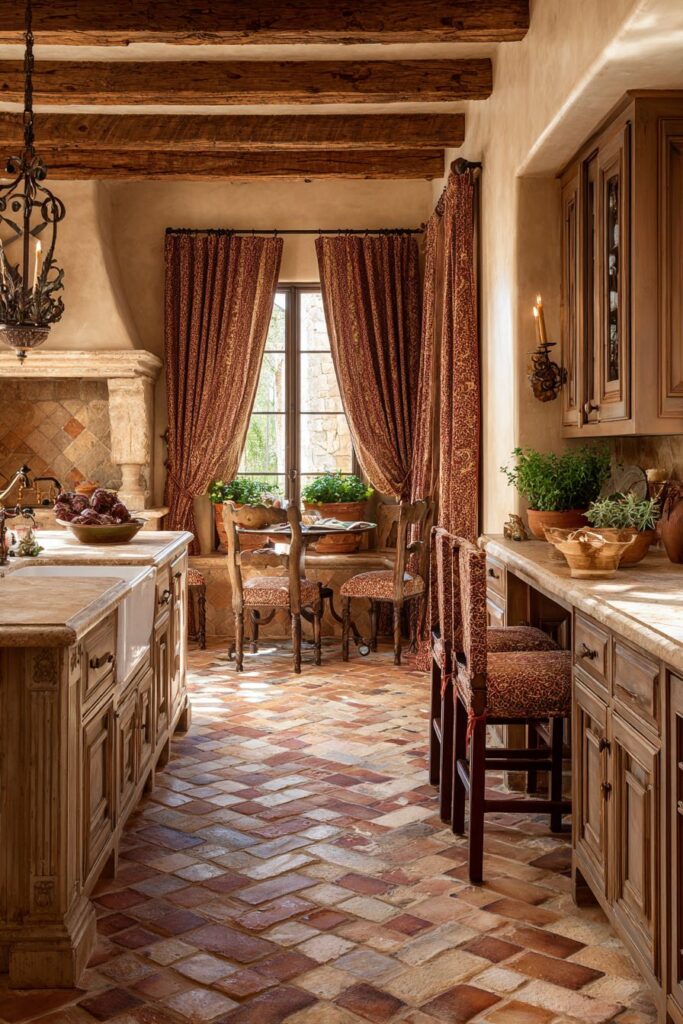
Key Design Tips:
- Choose rich, earth-toned colors that complement natural stone and terracotta elements
- Use traditional wrought iron hardware with decorative details for authentic Mediterranean appeal
- Incorporate hand-stitched or artisanal details to celebrate traditional craftsmanship
- Add living herbs in terracotta containers for agricultural connection
- Select natural stone and warm wood materials for architectural support
- Allow fabric to develop natural patina and character over time
12. Mid-Century Modern Boldness with Geometric Patterns

The optimistic spirit of mid-century modern design explodes into view through bold geometric print curtains featuring vibrant orange and teal patterns on crisp white backgrounds, suspended from sleek brass rods that capture the era’s love affair with warm metallic finishes. These confident window treatments demonstrate how pattern can serve as the primary decorative element in spaces characterized by clean lines and functional beauty. The scale and repetition of the geometric motifs create visual rhythm that energizes the entire kitchen.

Walnut cabinets and white Corian countertops provide the perfect period-appropriate backdrop for these statement curtains, while ceramic fruit bowls and other mid-century accessories complete the authentic vintage aesthetic. The interplay between the curtains’ bold patterns and the kitchen’s warm wood tones creates visual harmony that celebrates the era’s optimistic approach to domestic design.

Professional interior photography captures the curtains’ vibrant pattern while showcasing the kitchen’s authentic mid-century aesthetic through clean lines and warm wood tones. The brass hardware adds essential metallic warmth that bridges the curtains with other period-appropriate finishes throughout the space, demonstrating how consistent material choices support successful period design.

Key Design Tips:
- Choose bold geometric patterns in period-appropriate color combinations
- Use brass or warm metallic hardware for authentic mid-century appeal
- Coordinate patterns with existing color schemes while maintaining visual impact
- Select walnut or other warm wood tones for cabinetry and architectural elements
- Add period-appropriate accessories to complete the vintage narrative
- Balance bold patterns with clean architectural lines
13. Shabby Chic Romance with Ruffled Details
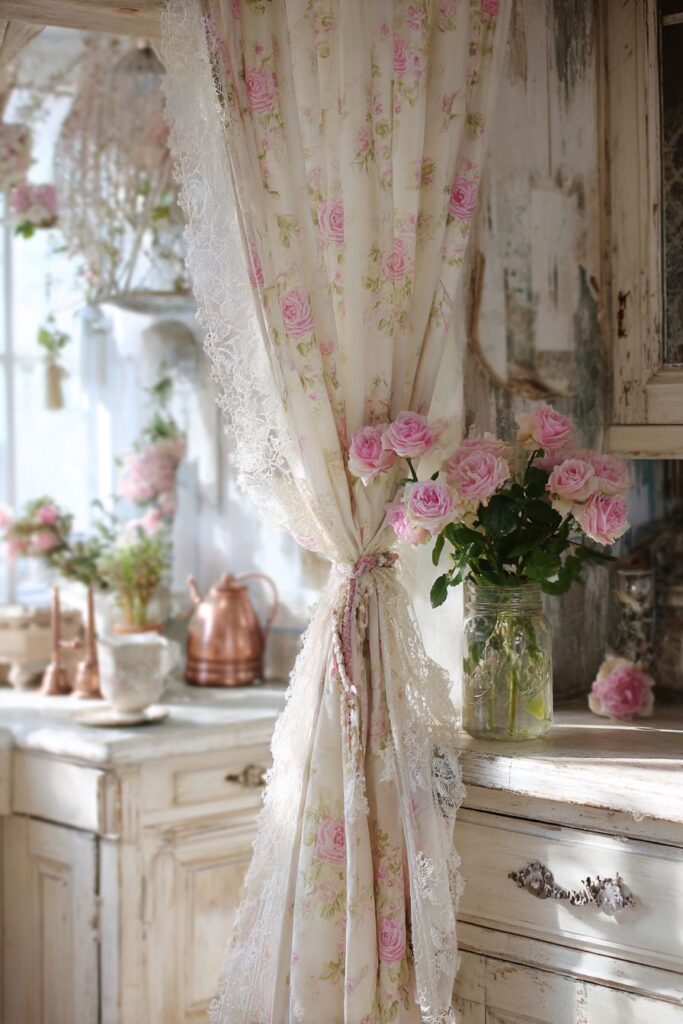
The gentle romance of shabby chic design finds its sweetest expression in ruffled white cotton curtains adorned with delicate pink rose patterns, gathered with vintage lace tie-backs that celebrate the style’s love affair with feminine details and aged beauty. These romantic window treatments demonstrate how soft textures and gentle patterns can create atmospheres of comfort and nostalgia that support relaxed living. The ruffled details add dimensional interest while maintaining the style’s essential softness.
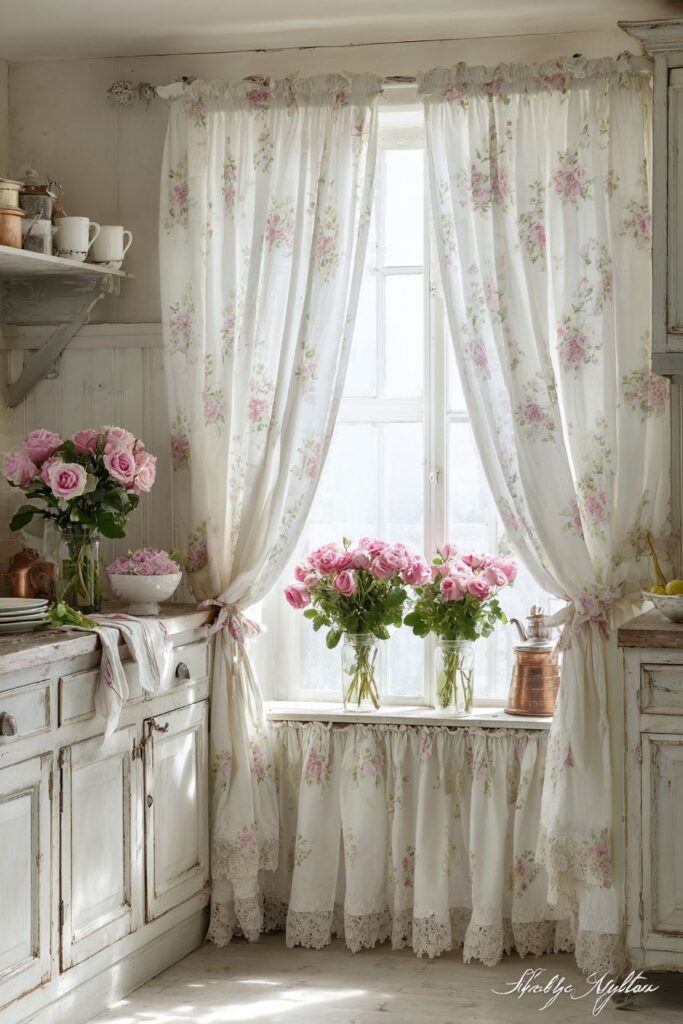
Distressed white cabinets and vintage copper accessories provide the perfect architectural framework for these romantic curtains, while fresh roses arranged in mason jars echo the curtain’s floral motifs and add living beauty that keeps the space feeling fresh rather than merely nostalgic. The coordination between textile patterns and fresh flowers demonstrates the shabby chic approach to creating layered, lived-in beauty.

Soft natural lighting in interior design photography highlights the curtains’ delicate details while showcasing the kitchen’s feminine vintage charm through aged patina finishes and romantic proportions. The pink rose pattern adds gentle color that enhances rather than dominates the predominantly white palette, proving that subtle pattern introduction can create significant visual impact.
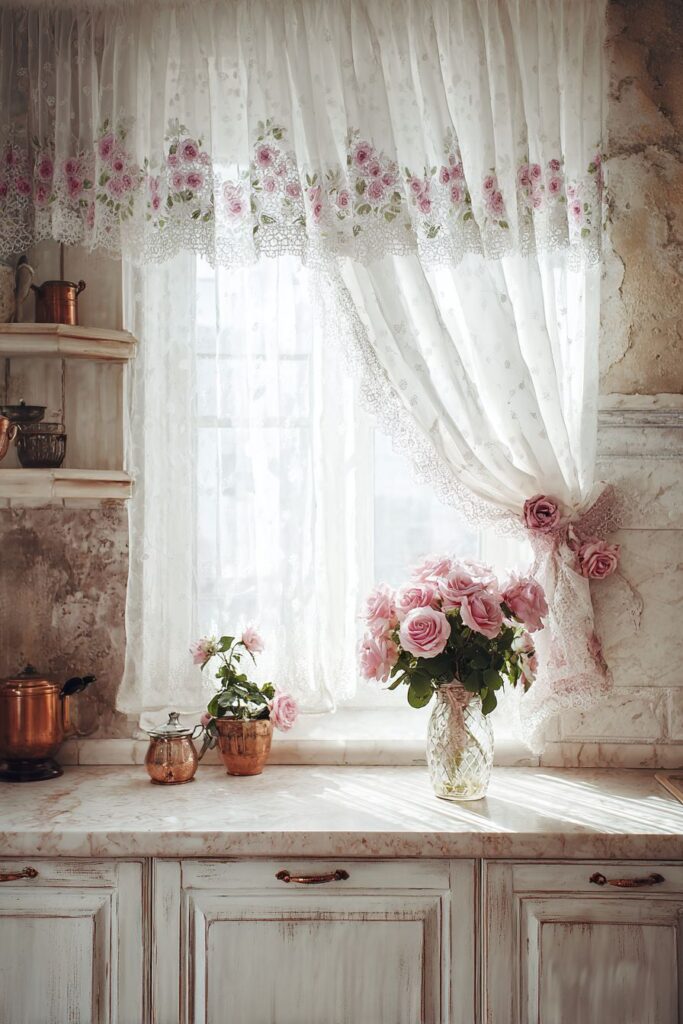
Key Design Tips:
- Choose soft floral patterns in gentle colors for authentic shabby chic appeal
- Add ruffled or gathered details for dimensional romantic interest
- Use vintage lace elements for texture and nostalgic authenticity
- Coordinate with distressed finishes and aged patina surfaces
- Incorporate fresh flowers to echo textile patterns with living elements
- Maintain predominantly light color palette with gentle accent colors
14. Eclectic Creativity with Mixed Patterns
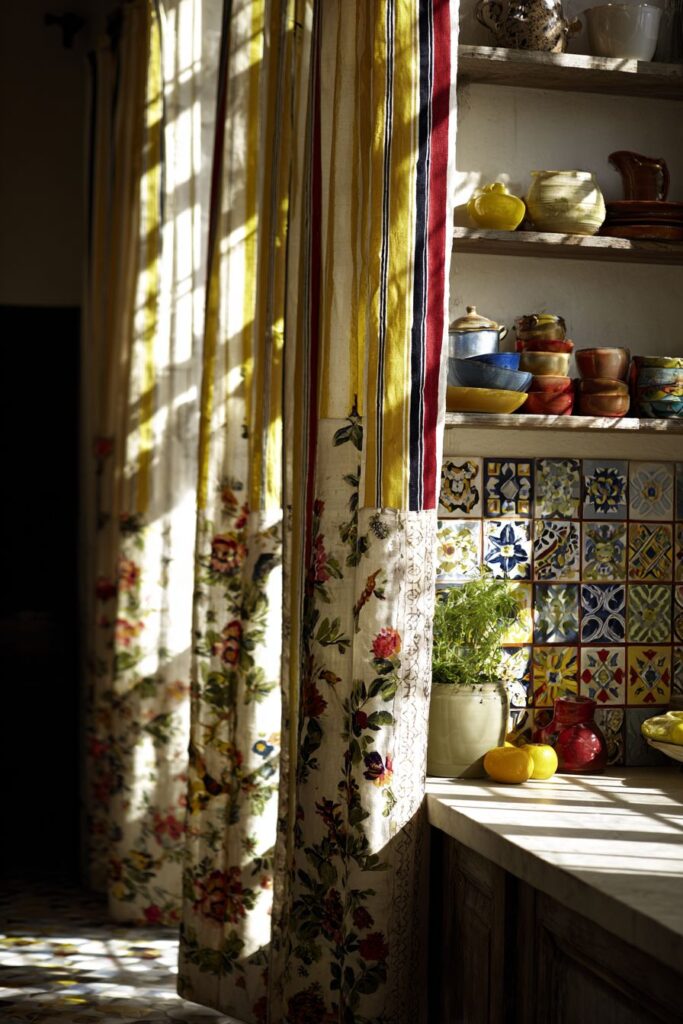
The artistic spirit of eclectic design celebrates creative freedom through mix-and-match patterned curtains that demonstrate how seemingly incompatible elements can create sophisticated visual harmony when united by skillful design principles. One panel featuring bold stripes pairs with another showcasing coordinating florals, both suspended from vintage brass rods that provide metallic continuity. This creative approach reflects confident design thinking that values personal expression over conventional matching.

The kitchen’s artistic personality shines through colorful tile backsplashes and open shelving displaying collected ceramics that tell personal stories through accumulated objects. Natural daylight creates interesting shadow patterns through the varied curtain designs, adding dynamic visual interest that changes throughout the day. The successful integration of multiple patterns requires careful attention to color coordination and scale relationships.
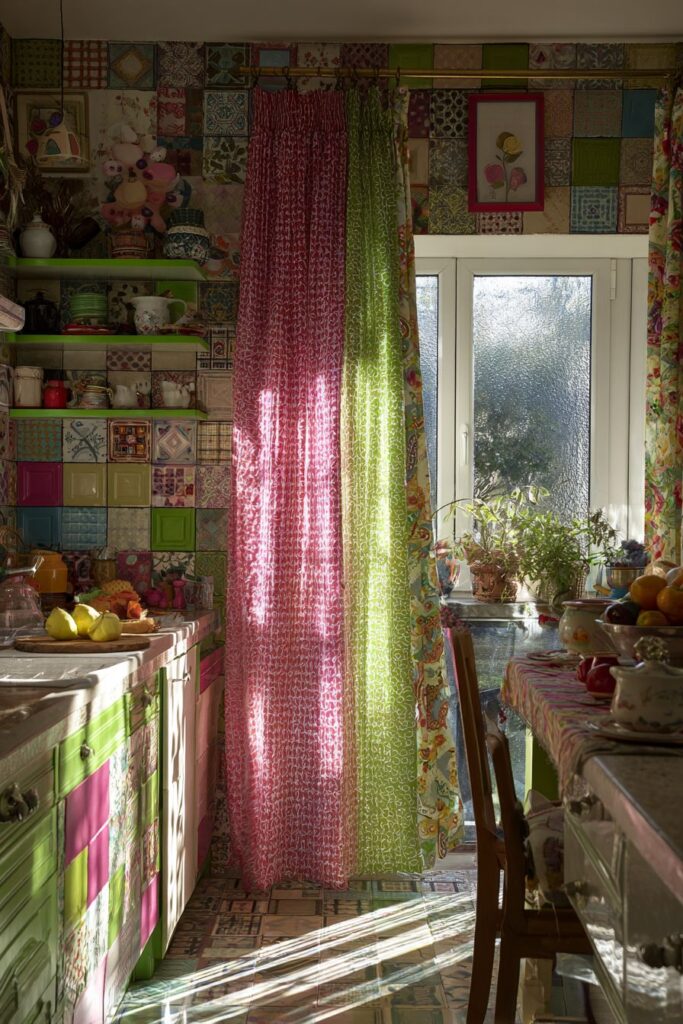
Wide-angle interior photography captures the successful integration of multiple patterns within the vibrant kitchen space, demonstrating how eclectic design can achieve sophisticated results through confident material mixing. The vintage brass hardware provides essential continuity that allows the different patterns to work together harmoniously while maintaining individual character.
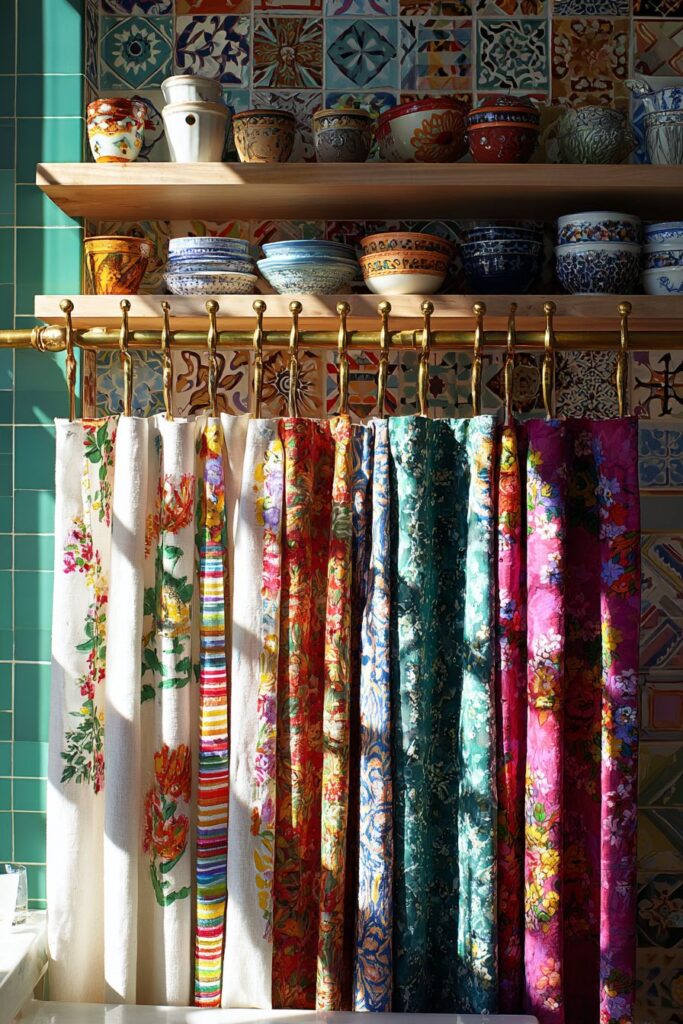
Key Design Tips:
- Choose patterns with common color elements for visual coordination
- Vary pattern scales to create visual interest without overwhelming chaos
- Use consistent hardware finishes to provide unifying elements
- Balance busy patterns with solid color surfaces for visual rest
- Display personal collections that support the eclectic aesthetic narrative
- Maintain confident approach to unconventional pattern combinations
15. Asian-Inspired Serenity with Bamboo Panels

The peaceful philosophy of Asian design finds perfect expression in bamboo panel curtains featuring natural fiber accents that slide gracefully on wooden tracks, creating window treatments that celebrate simplicity, natural materials, and harmonious proportions. These organic panels complement views of zen gardens while maintaining the clean horizontal lines characteristic of Asian-inspired architecture. The sliding mechanism eliminates visual clutter while providing smooth, quiet operation.

Minimalist wooden cabinets and stone countertops create the perfect architectural framework for these serene curtains, while a small bonsai tree positioned on the windowsill reinforces the Asian connection to nature and contemplative living. The integration of living elements adds spiritual dimension that transforms the kitchen into a space for mindful food preparation and quiet reflection.

Professional interior photography with soft diffused lighting showcases the curtains’ natural texture while highlighting the kitchen’s serene aesthetic through clean horizontal lines and natural material combinations. The bamboo’s organic patterns and color variations add visual interest while maintaining the essential calm that defines successful Asian-inspired design.

Key Design Tips:
- Choose natural bamboo materials with organic texture variations
- Use sliding track systems for smooth, quiet operation
- Maintain clean horizontal lines throughout the architectural composition
- Incorporate single living element like bonsai for spiritual connection
- Select natural stone and wood materials for material harmony
- Emphasize simplicity and functional beauty over decorative complexity
16. Art Deco Glamour with Emerald Silk
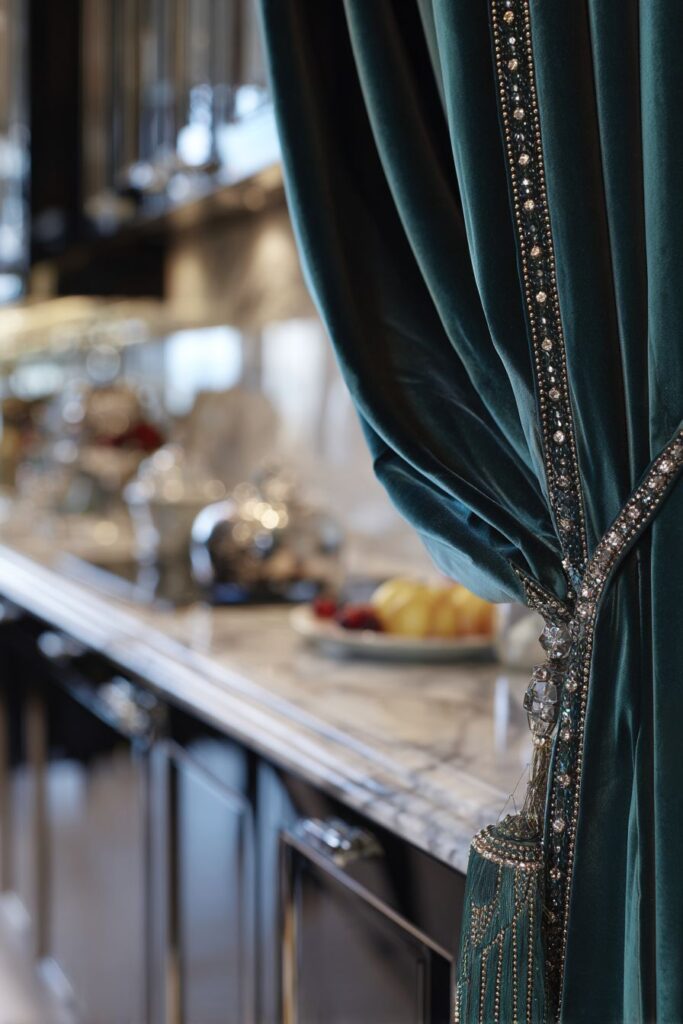
The luxurious sophistication of Art Deco design reaches its dramatic peak in sumptuous silk curtains crafted in deep emerald green and adorned with gold geometric trim, suspended from polished chrome rods featuring stepped details that echo the era’s love affair with machine-age aesthetics. These glamorous window treatments demonstrate how rich materials and bold colors can create theatrical impact while maintaining the geometric precision that defines Art Deco style. The emerald color provides dramatic depth against lighter architectural elements.
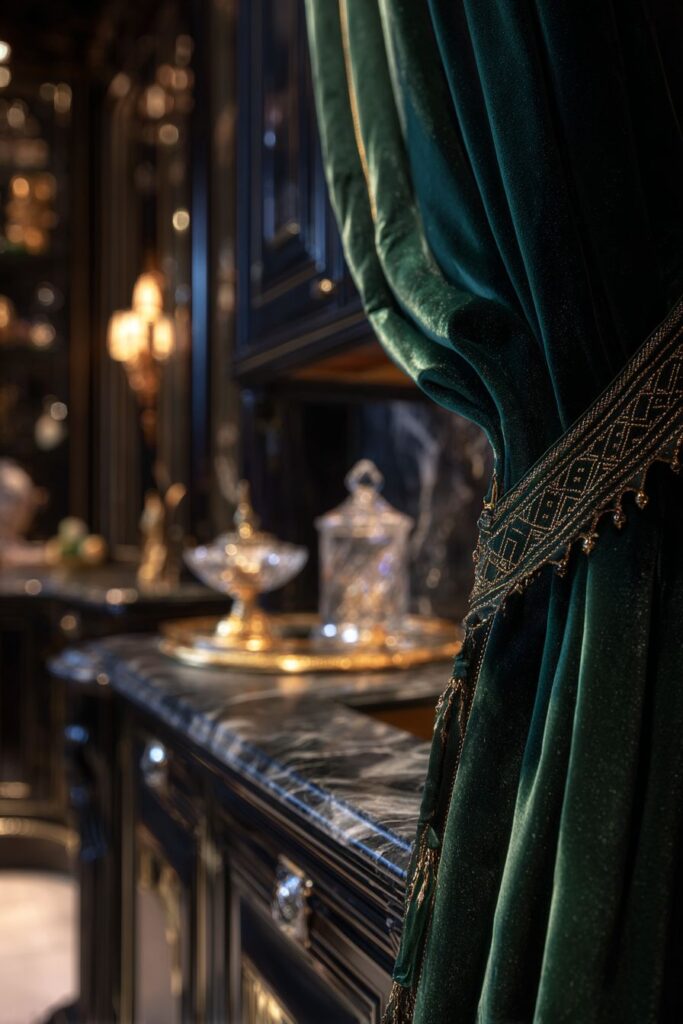
Black lacquer cabinets and marble countertops with gold veining create the perfect architectural backdrop for these statement curtains, while crystal cabinet knobs catch and reflect light to add sparkle throughout the space. The integration of multiple luxury materials – silk, chrome, marble, and crystal – creates layered richness that speaks to the Art Deco celebration of opulence and technological innovation.
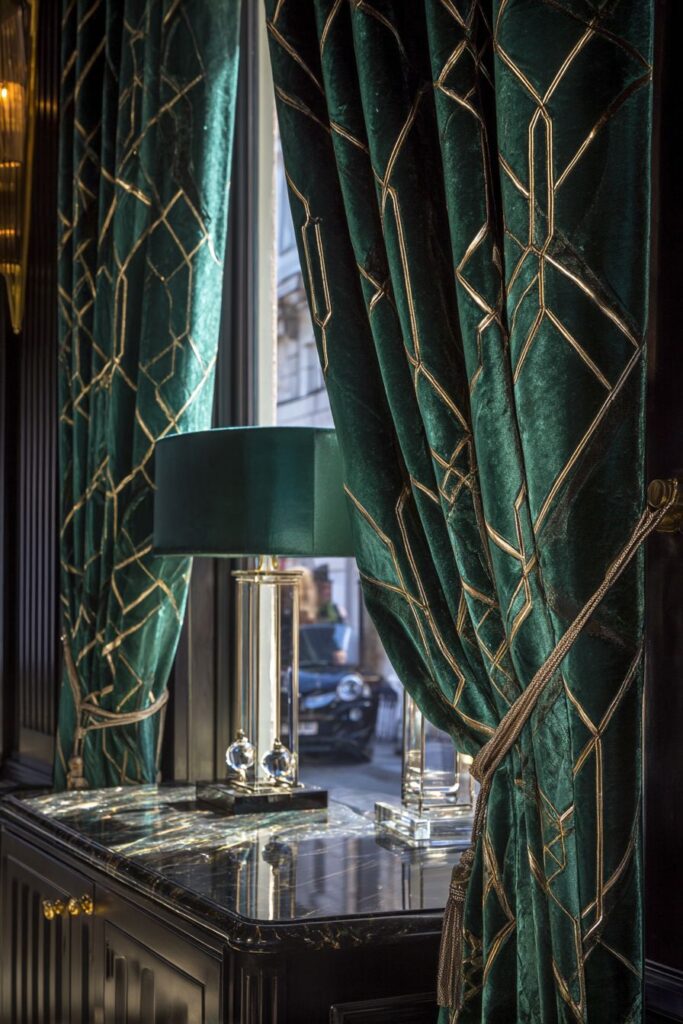
Interior design photography with dramatic lighting emphasizes the curtains’ rich color and lustrous silk texture while showcasing the kitchen’s sophisticated 1920s-inspired elegance through metallic accents and geometric proportions. The gold trim detail adds essential warm metallic contrast that bridges the cool chrome hardware with the rich emerald fabric, demonstrating sophisticated color and material coordination.
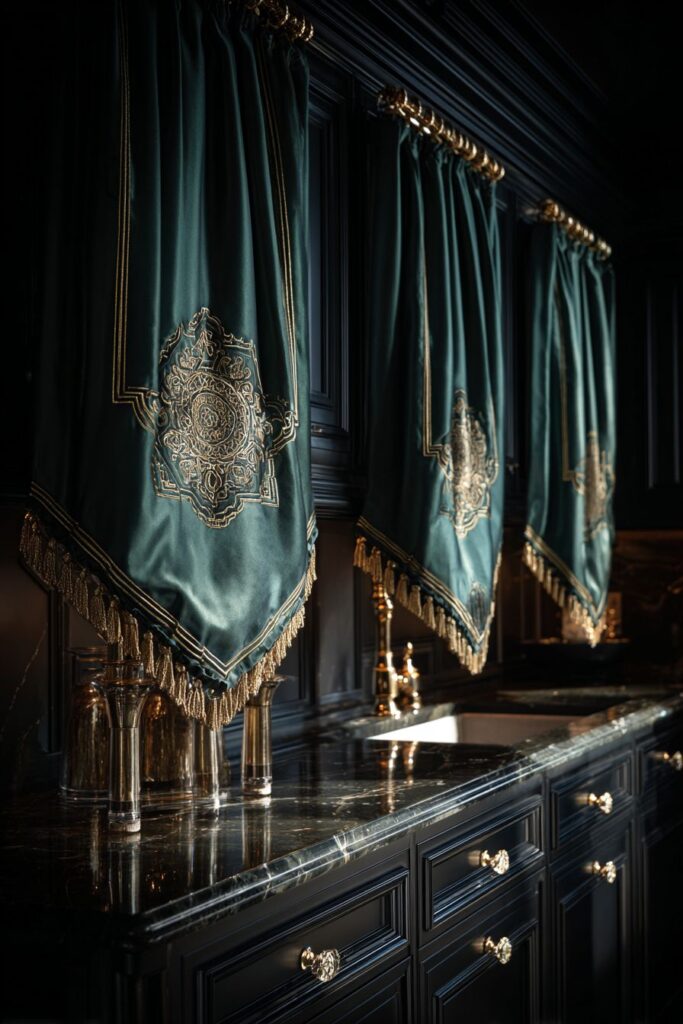
Key Design Tips:
- Choose luxury materials like silk for authentic Art Deco glamour and texture
- Use bold colors with metallic accents for dramatic visual impact
- Select chrome or polished metal hardware with geometric stepped details
- Coordinate with marble, lacquer, and other luxury surface materials
- Add crystal or glass elements for light reflection and sparkle
- Maintain geometric precision in all design elements and proportions
17. Transitional Elegance with Pinch Pleat Sophistication
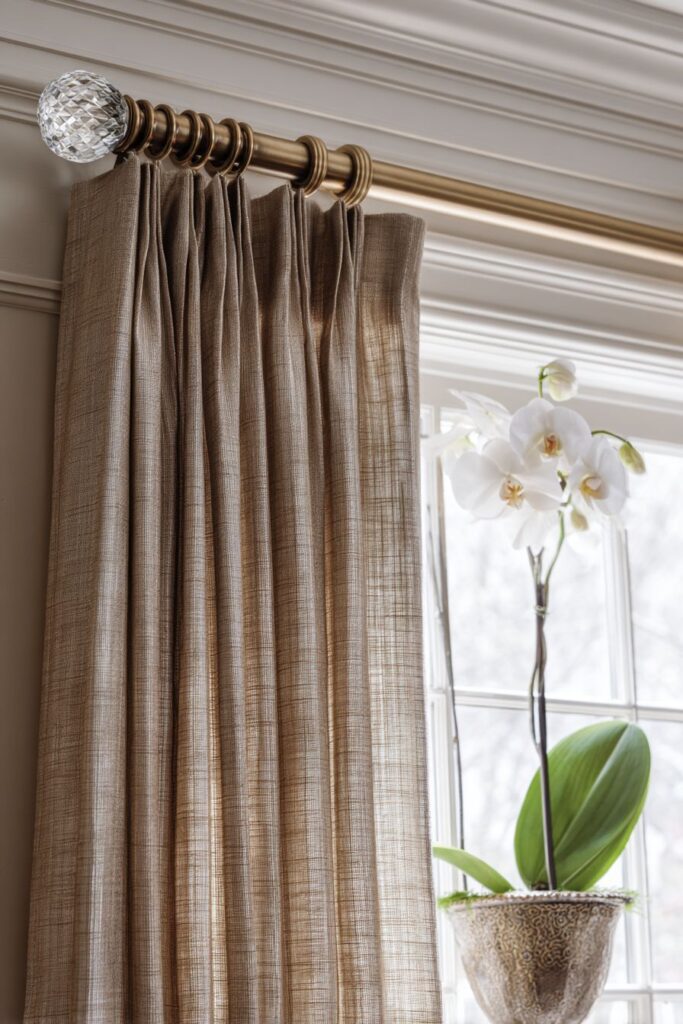
The refined versatility of transitional design finds perfect expression in classic pinch pleat curtains crafted from warm taupe linen, suspended from antique brass rods adorned with crystal finials that bridge traditional craftsmanship with contemporary sophistication. These tailored window treatments demonstrate how traditional techniques can enhance modern spaces while maintaining timeless elegance. The neutral fabric color provides sophisticated foundation that supports both classic and contemporary design elements.
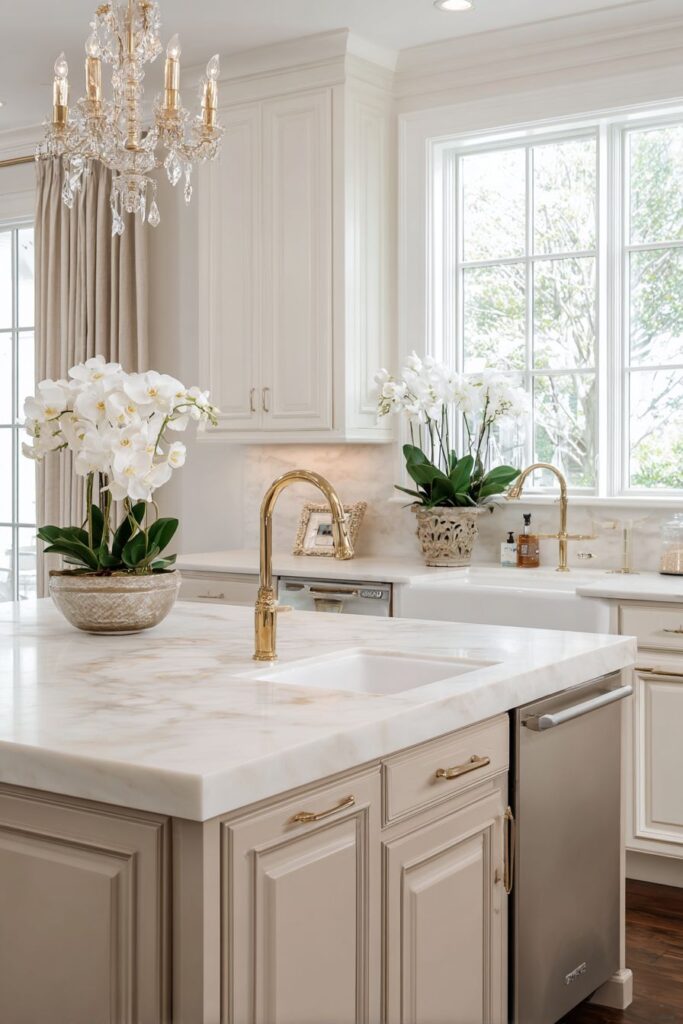
White shaker cabinets and pristine quartz countertops create clean architectural framework that allows the curtains’ tailored sophistication to shine, while fresh white orchids add natural elegance to windowsill displays. The coordination between the curtains’ warm neutral tone and the space’s mixed metal finishes creates visual harmony that supports the transitional style’s essential versatility.

Balanced interior photography captures the curtains’ tailored sophistication while showcasing the kitchen’s timeless appeal through mixed metal finishes and classic proportions. The antique brass hardware provides warm metallic contrast that enhances the taupe fabric while coordinating with other brass elements throughout the space, demonstrating how consistent material choices support successful transitional design.

Key Design Tips:
- Choose neutral colors that support both traditional and contemporary elements
- Use traditional tailoring techniques like pinch pleats for sophisticated structure
- Select mixed metal finishes that bridge different style periods
- Coordinate with classic cabinet styles and contemporary surface materials
- Add fresh flowers or plants for natural elegance and living beauty
- Maintain quality craftsmanship in all construction and installation details
18. Cottage Cheerfulness with Gingham and Scallops
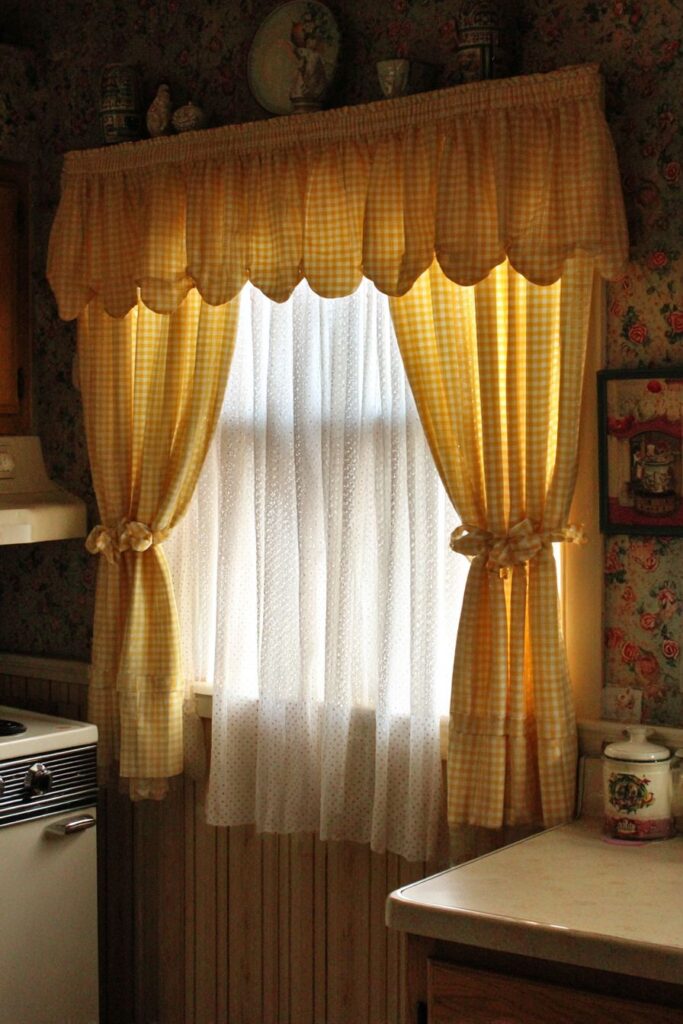
The sunny optimism of cottage design radiates through cheerful yellow gingham curtains featuring scalloped valances that celebrate the style’s love affair with pattern, texture, and welcoming color. These delightful window treatments, tied back with matching fabric bows, transform ordinary windows into sources of joy that support the cottage philosophy of creating spaces that nurture family life and casual hospitality. The sunny yellow color adds warmth that enhances natural light throughout the day.
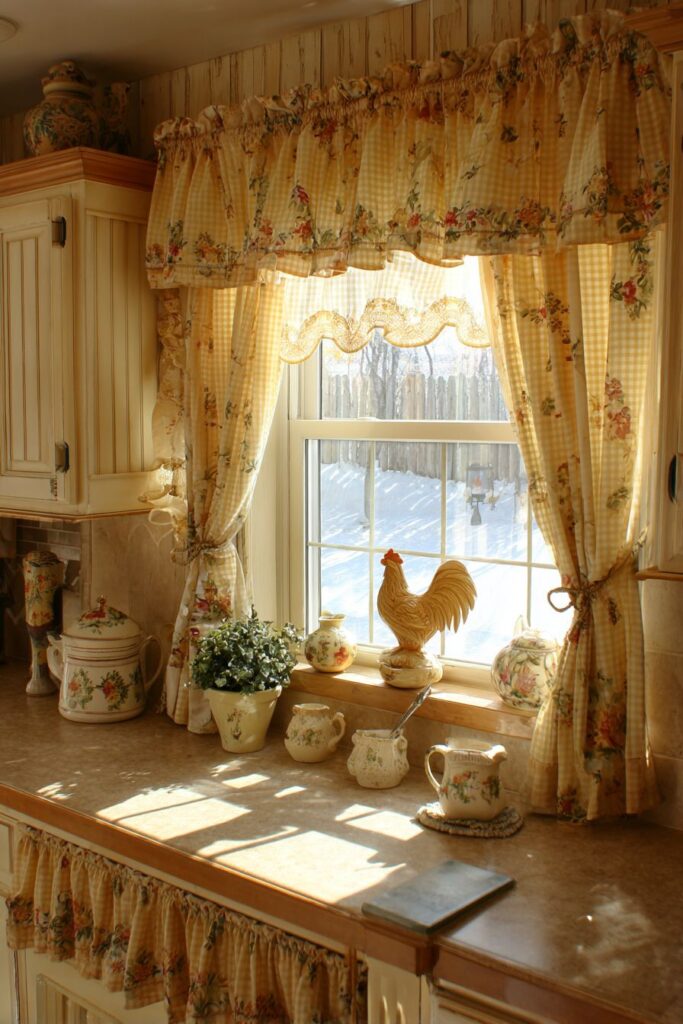
Beadboard wainscoting and vintage appliances provide authentic cottage architectural framework, while ceramic rooster collections decorating the windowsill add whimsical charm that supports the style’s celebration of personal collections and found treasures. The integration of vintage elements with cheerful textiles creates layered comfort that invites relaxation and casual gathering.
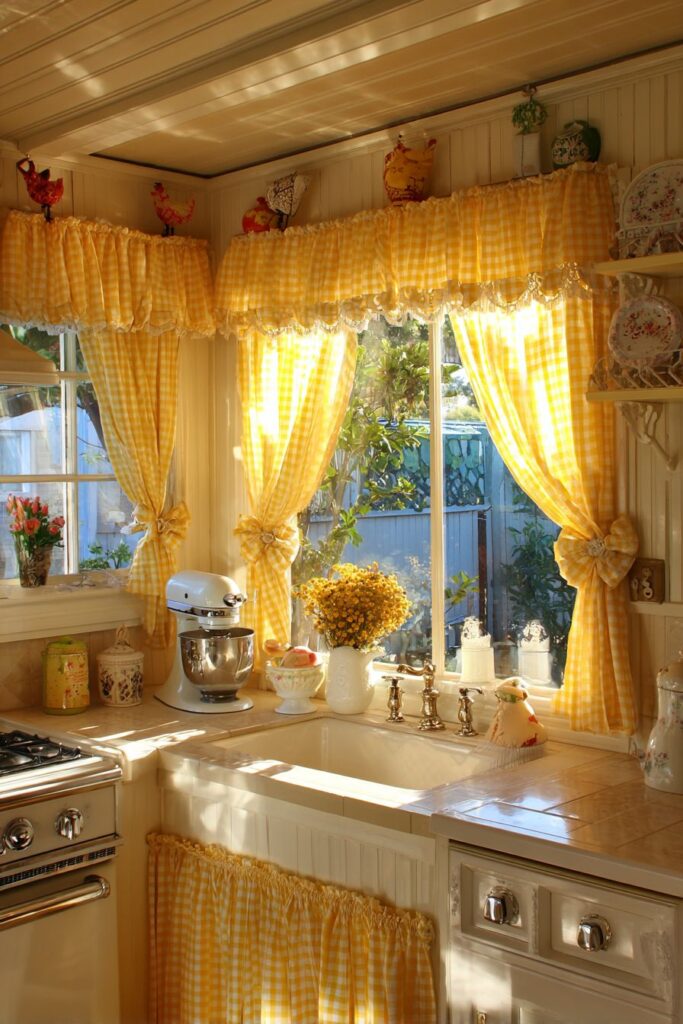
Professional interior photography with warm natural lighting highlights the curtains’ cottage charm while showcasing the kitchen’s welcoming country atmosphere through painted wood finishes and vintage accessories. The gingham pattern adds visual rhythm that energizes the space while maintaining the essential comfort that defines successful cottage design.
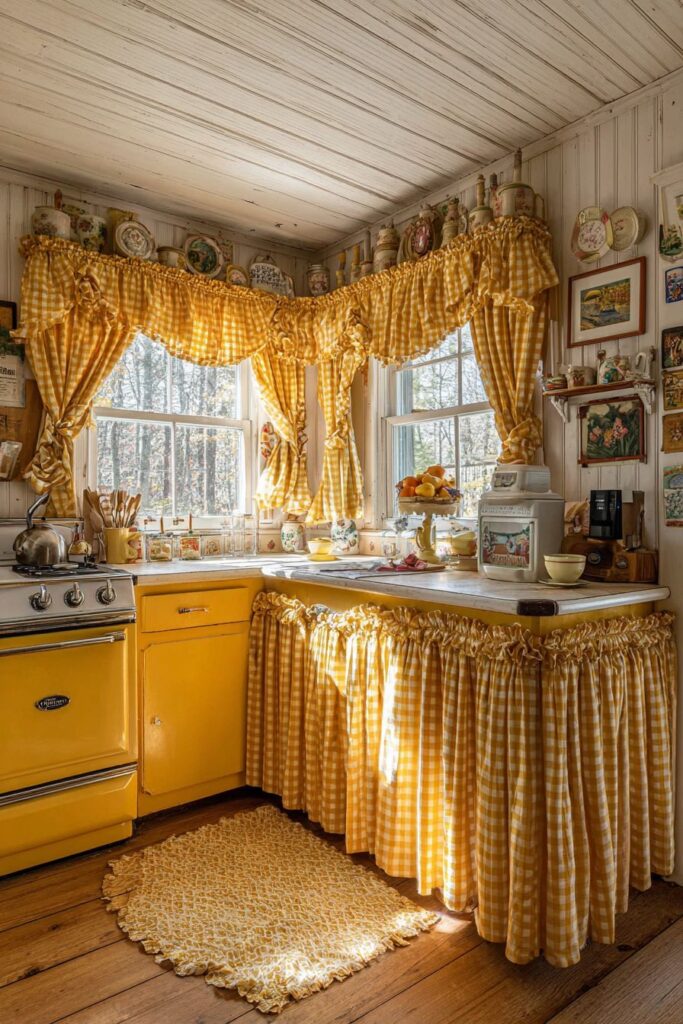
Key Design Tips:
- Choose cheerful colors that enhance natural light and create welcoming atmosphere
- Add traditional details like scalloped valances for authentic cottage charm
- Use matching fabric elements like bows or tie-backs for design continuity
- Incorporate vintage or antique elements for nostalgic authenticity
- Display personal collections that tell family stories and add character
- Maintain casual comfort while achieving sophisticated pattern coordination
19. Contemporary Farmhouse Refinement with Contrast Piping

The sophisticated evolution of farmhouse design finds elegant expression in linen-cotton blend curtains crafted in soft grey with crisp white contrast piping, suspended from modern black metal rods featuring geometric brackets that bridge rustic inspiration with contemporary precision. These refined window treatments demonstrate how traditional farmhouse elements can be updated for modern living while maintaining essential warmth and authenticity. The contrast piping adds tailored sophistication that elevates the overall design.
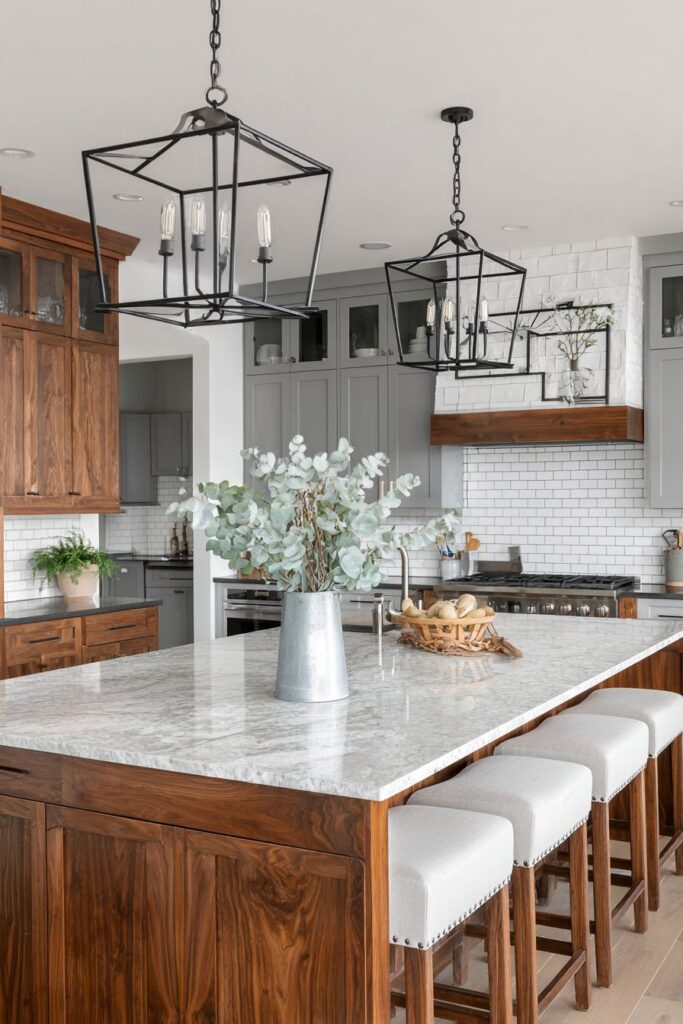
White subway tile and dark wood island create classic architectural framework with contemporary updates, while fresh eucalyptus arranged in galvanized vessels adds natural texture that connects the space to farmhouse agricultural roots. The coordination between soft grey curtains and mixed finishes creates sophisticated neutrality that supports both casual family life and elegant entertaining.
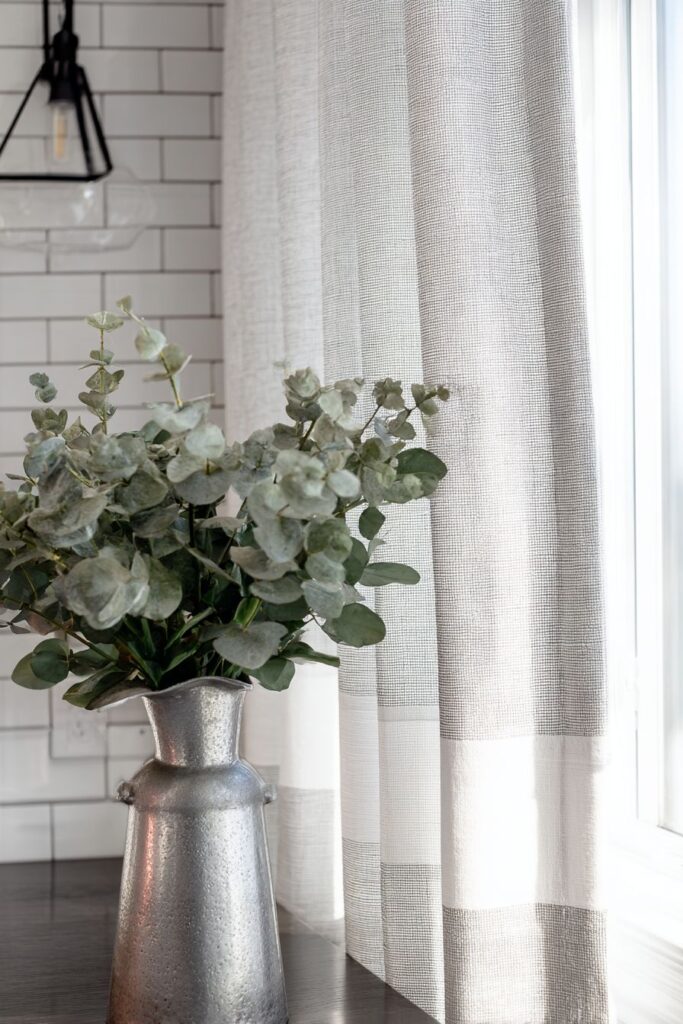
Interior design photography with balanced exposure showcases the curtains’ refined simplicity while highlighting the kitchen’s updated farmhouse style through mixed textures and finishes. The black metal hardware provides contemporary contrast that enhances the grey fabric while coordinating with other dark elements throughout the space, demonstrating how thoughtful contrast creates visual interest and modern sophistication.

Key Design Tips:
- Choose refined fabric blends that combine traditional materials with contemporary performance
- Add contrast piping or trim details for tailored sophistication
- Use modern hardware finishes like matte black for contemporary edge
- Coordinate neutral colors with mixed texture combinations
- Incorporate natural elements like eucalyptus for organic softness
- Balance traditional farmhouse elements with contemporary precision and clean lines
20. Urban Loft Drama with Burgundy Velvet

The theatrical sophistication of urban loft living reaches its dramatic crescendo in floor-to-ceiling curtain panels crafted from luxurious burgundy velvet, suspended from industrial black steel cable systems that celebrate the loft aesthetic’s marriage of luxury and authenticity. These substantial window treatments add essential warmth and acoustic softness to spaces dominated by hard materials while creating bold visual statements that anchor the overall design scheme. The rich burgundy color provides sophisticated drama against neutral architectural elements.

Exposed brick walls and polished concrete floors create authentic industrial framework that supports these luxurious curtains, while vintage leather bar stools complement the velvet’s sumptuous texture through coordinated material richness. The integration of luxury textiles with raw architectural elements demonstrates the loft style’s essential sophistication and urban refinement.

Wide-angle interior photography captures the curtains’ bold impact while highlighting how they successfully soften raw industrial elements throughout the spacious kitchen with high ceilings and exposed metal fixtures. The burgundy color adds essential warmth that transforms potentially cold industrial spaces into sophisticated environments that support both casual living and elegant entertaining.

Key Design Tips:
- Choose luxury fabrics like velvet for dramatic texture and acoustic softening
- Use industrial cable systems or substantial hardware for authentic loft appeal
- Select rich colors that provide warmth against neutral industrial materials
- Coordinate with leather and other luxury materials for sophisticated texture layering
- Emphasize dramatic scale appropriate to loft proportions and high ceilings
- Balance raw architectural elements with luxury textile sophistication
Why These Kitchen Curtain Ideas Represent the Best Design Solutions
These twenty kitchen curtain concepts represent the pinnacle of contemporary window treatment design because they address the unique challenges of kitchen environments while delivering exceptional aesthetic impact. Kitchen curtain ideas must balance functionality with beauty, durability with style, and practicality with personal expression. Each design solution presented here demonstrates mastery of these complex requirements through thoughtful material selection, appropriate scale consideration, and sophisticated color coordination.
The best kitchen curtains featured in this collection succeed because they understand the kitchen’s dual role as functional workspace and social gathering place. From the farmhouse elegance of white linen panels to the urban sophistication of burgundy velvet, these window treatment ideas prove that thoughtful design can enhance cooking experiences while creating atmospheres that support family life and entertaining. The variety of styles ensures that every kitchen aesthetic – from traditional country to cutting-edge contemporary – can find perfect curtain solutions.
Modern kitchen curtains like the minimalist grey panels and automated sage shades demonstrate how technology and contemporary materials can enhance traditional window covering functions while maintaining clean aesthetic lines. These solutions prove that contemporary curtain designs can embrace innovation without sacrificing beauty or comfort. The integration of smart home technology with quality fabrics represents the future of residential window treatments.
Traditional kitchen curtains including the gingham café styles and French country toile patterns demonstrate timeless appeal that transcends passing design trends. These classic curtain styles prove that well-executed traditional designs remain relevant and beautiful across generations, providing comfort through familiar patterns and trusted materials. The enduring popularity of these approaches speaks to their fundamental success in creating welcoming kitchen environments.
The fabric choices represented in this collection – from practical canvas to luxurious silk – demonstrate comprehensive understanding of how different materials perform in kitchen environments while contributing to overall design success. Linen kitchen curtains offer natural texture and easy maintenance, while cotton curtains provide versatility and affordability without compromising style. Natural fiber options like hemp and jute add organic authenticity that supports sustainable living principles.
Color coordination throughout these designs demonstrates sophisticated understanding of how curtain colors interact with kitchen elements like cabinetry, countertops, and backsplashes. From neutral palettes that provide flexible design foundations to bold color statements that energize entire spaces, these color schemes prove that successful curtain design requires careful consideration of existing architectural elements and desired atmospheric outcomes.
The installation methods showcased – from simple rod systems to complex automated mechanisms – demonstrate how proper hardware selection and installation technique can enhance both curtain function and aesthetic impact. Hardware choices including brass, black metal, and natural wood demonstrate how supporting elements contribute to overall design success while providing reliable long-term performance.
Maintenance considerations inherent in these designs prove that beautiful kitchen curtains can be practical and easy to care for without compromising style or sophistication. The fabric selections and construction methods featured ensure that these curtains will maintain their beauty through regular use and cleaning cycles that kitchen environments demand.
Conclusion
The journey through these twenty exceptional kitchen curtain ideas reveals the remarkable potential of thoughtful window treatment design to transform culinary spaces from merely functional to truly inspiring. Each concept demonstrates unique approaches to balancing the practical demands of kitchen environments with the aesthetic aspirations of homeowners who understand that beautiful spaces enhance daily life experiences. From the rustic charm of burlap and lace to the technological sophistication of automated systems, these designs prove that there are no limits to creative expression when fundamental design principles guide material selection and installation choices.
The diversity of styles presented – spanning farmhouse elegance, modern minimalism, bohemian creativity, and industrial sophistication – demonstrates that successful kitchen curtain design transcends specific aesthetic preferences to embrace broader principles of functionality, beauty, and personal expression. Whether drawn to the romantic patterns of French country toile or the clean geometry of mid-century modern prints, homeowners can find inspiration that resonates with their lifestyle needs and design sensibilities while enhancing their kitchen’s role as the heart of the home.
The careful attention to material properties, color coordination, and installation methods throughout these designs provides practical guidance for homeowners ready to transform their own kitchen spaces. By understanding how different fabrics perform in kitchen environments, how colors interact with existing architectural elements, and how proper hardware selection enhances both function and aesthetics, readers can approach their own curtain projects with confidence and clear direction.
As you consider implementing these ideas in your own culinary sanctuary, remember that the most successful kitchen curtains are those that reflect your personal style while meeting your practical needs. Whether you choose to embrace bold patterns that energize morning routines or prefer subtle textures that create calm evening atmospheres, the key lies in selecting solutions that enhance your daily experiences while creating spaces that welcome family and friends to gather, cook, and create lasting memories together.
